

17 Best Places to Visit in Vietnam
Written by Jess Lee Updated Aug 30, 2023
Vietnam is an astonishing mix of natural highlights and cultural diversity.
The scenery ranges from jagged peaks seen from winding mountain passes down to verdant paddy fields painted every shade of green in the palette, while Vietnam's long history and multicultural population (with over 50 ethnic minority groups) make a trip here rich in heritage.
Outdoor lovers can get their teeth into the countryside within the numerous national parks, where hiking, biking, and kayaking are popular things to do, but Vietnam's most famous natural tourist attraction, the spectacular karst seascape of Halong Bay, is one natural sight that even the more slothful can experience up close on a cruise.
While the rural areas brim with lush panoramas, the big cities buzz with contemporary life and provide ample opportunities to get stuck into Vietnam's tasty culinary highlights.
This fascinating country is full of surprises and is one of Southeast Asia's most underrated destinations. Plan your sightseeing with our list of the best places to visit in Vietnam.
Ho Chi Minh City
Phong nha-ke bang national park, sapa countryside, cu chi tunnels, ba be national park, mekong delta, cat ba island, phu quoc island, con dao islands, frequently asked questions, when is the best time to visit vietnam.
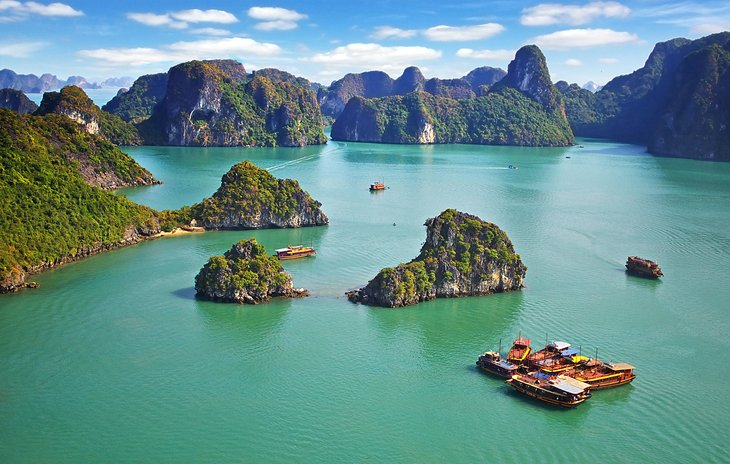
The karst seascape of Halong Bay is one of the best places to visit in the world for spellbinding sea views and is a UNESCO World Heritage Site.
Thousands of limestone islands sit within this bay in the Gulf of Tonkin, eroded into jagged pinnacles by wind and water action over millennia.
With the bay's scenery best seen by boat, this is prime cruising territory. Opt for at least an overnight tour to see Halong Bay's iconic views as a day trip doesn't do it justice.
There are plenty of caves in the bay that can be entered including the Hang Sung Sot, with three mammoth caverns, and the Hang Dao Go, with superbly weird stalagmites and stalactites. For most people though, the highlight is simply cruising amid the karsts and soaking up the changing scenery of pinnacles as you pass by.
There are plenty of different cruise tours to choose from. Check the different itineraries offered before booking as many travelers have left Halong Bay underwhelmed by their cruise.
Author's Tip: If possible, book a tour that takes in neighboring Lan Ha Bay as well as Halong Bay. The karst scenery is just as dramatic here but fewer cruise trips visit. And check if your cruise offers included activities such as guided kayaking (which allows you to experience an up-close view of the scenery).
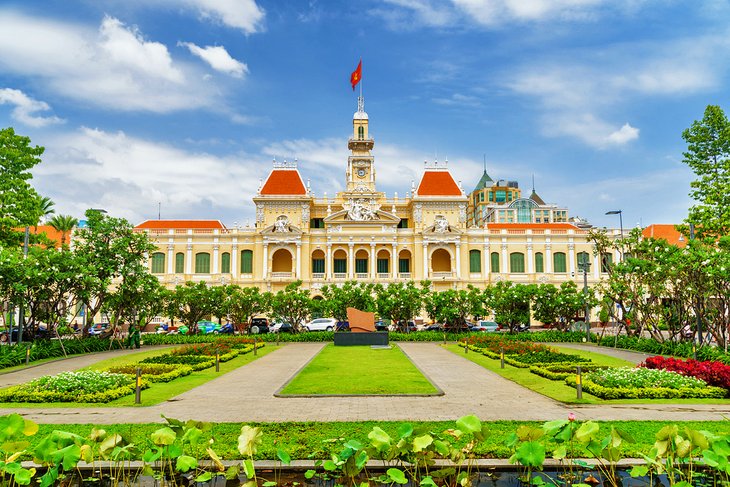
For big city fans, no visit to Vietnam is really complete without a visit to Ho Chi Minh City, the buzzing commercial hub of the country.
The streets are an insane clog of motorbikes and cars, the restaurant and café scene is incredibly cosmopolitan, and the shopping is the best in the country.
At its center is Dong Khoi, a relatively small and easily navigable central district, which holds most of the city's sights.
Here, you'll find the HCMC Museum, with a brilliant collection of artifacts that weaves together the story of the city, and the grand Notre Dame Cathedral, built in the late 19th century.
Check out the old district of Da Kao nearby for some of the best surviving examples of the city's French colonial architecture and also to visit the Jade Emperor Pagoda with its dazzling array of Buddhist and Taoist religious iconography.
Afterwards, the History Museum is a must-do for history fans with stacks of relics on display from various archaeological sites.
For many visitors, the two big-hitter tourist attractions not to miss are just a little out of the center, along Nguyen Thi Minh Khai Street. The Reunification Palace, then known as Independence Palace, was the residence for South Vietnam's president. It's chiefly famous as the spot where North Vietnam's tanks stopped on 30 April 1975, officially ending the war. It's a completely fascinating place to visit complete with 1960s furnishings still in situ.
Nearby is the War Remnants Museum, which although very obviously biased, paints a disturbing picture of the brutality of war and the many atrocities committed by US Forces during their Vietnam campaign.
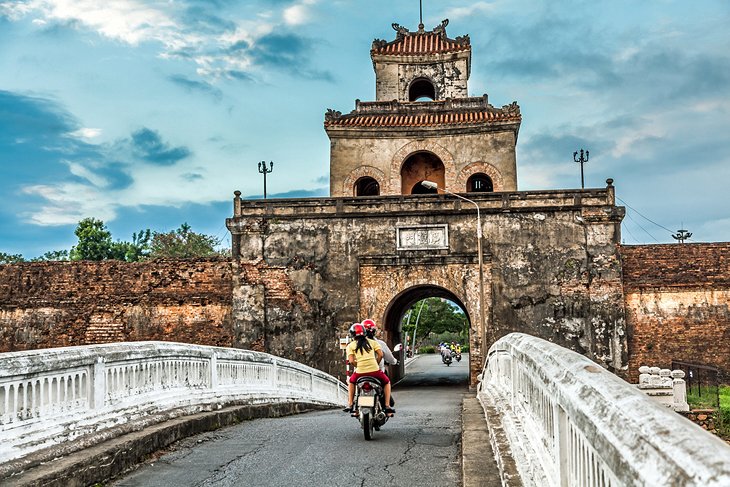
One of Vietnam's most historic towns, Hue is packed to the brim with relics from the reign of the 19th-century Nguyen emperors.
Sitting along the banks of the gorgeous Perfume River, the Imperial Enclosure is a huge site set within walls that sprawl for 2.5 kilometers.
While touring the grounds check out the gorgeous Ngo Mon Gate, the Thai Hoa Palace with its finely lacquered interior detailing, the Dien Tho Residence where the Queen Mothers would live, and the Halls of Mandarins with its preserved ceiling murals.
A dazzling number of historic sites lie outside the Imperial Enclosure walls as well.
One of the nicest ways of visiting a collection of outlying sites is by taking a riverboat cruise on the Perfume River. A day cruise can take you to visit several royal tombs along with some pagodas.
If you're short on time, the best tomb to visit is the Tomb of Tu Doc and the most important pagoda in the area is the Thien Mu Pagoda, with its tower that soars for 21 meters high.
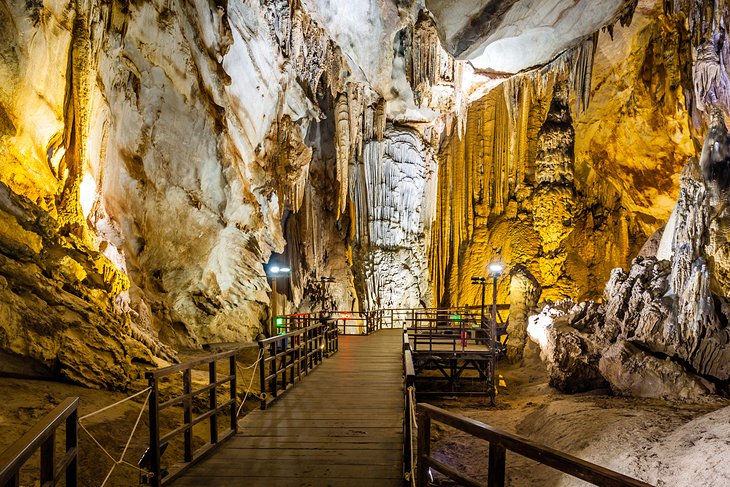
One of the best places to visit in Vietnam for caving, World Heritage-listed Phong Nha-Ke Bang National Park is a dramatic karst mountain formation honeycombed with huge caverns, which are home to superb stalactite and stalagmite displays.
It's best known for its caving activities , which range from multi-day hiking and caving tours for the more adventurous, to simpler half-day trips to caves with easy access provided by boat trips and modern boardwalks, but the national park also offers mountain biking and trekking activities.
The most popular destinations within the park are the Paradise Cave , which extends for a staggering 31 kilometers below ground, and the Phong Nha Cave, where the interior is accessed by boat. Half-day tours can be easily arranged once you're in the area.
The national park's most renowned caverns though are Son Doong Cave (the world's largest cave) , and the Tu Lan Cave with its cavern river system. Access to these, and to certain other caves in the park are restricted to organized tours (ranging from one-day to multi-day expeditions) which are all run by Phong Nha's expert adventure tour company Oxalis . It's well worth booking in advance to secure your spot.
To make the most of your time here, time your visit for outside the rainy season, which runs from October to December, when many of the national park's caves are closed to the public.
You can access Phong Nha-Ke Bang National Park from Son Trach (also known as Phong Nha village).
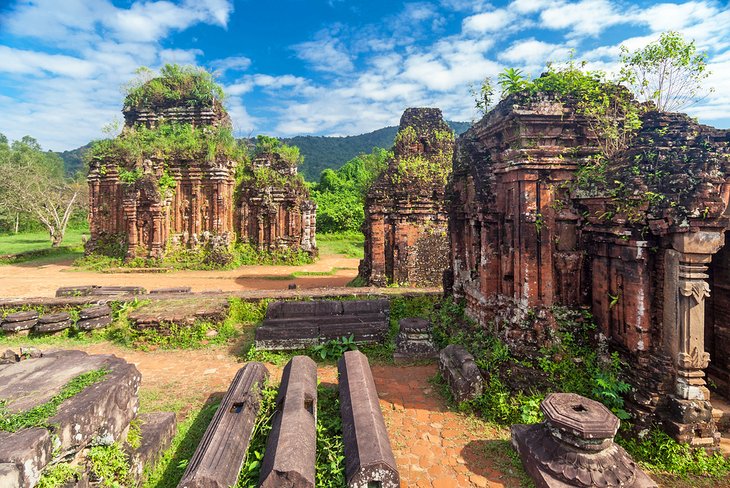
Surrounded by lush jungle-covered mountains, My Son is a ruined Cham era temple city that dates from the 4th century.
This old Hindu religious center was still very much in use during the 7th to 10th centuries and only fell into complete decline and abandonment during the 13th century.
There are around 20 temple structures still standing here, all built of brick or sandstone blocks and showing interesting influences from various Asian empires, including Indian and Malay.
Note that the temples of Group B are the oldest, while Group A once contained the site's most important monument but was destroyed deliberately by US forces during the Vietnam War.
A good museum on-site houses plenty of information on the Cham.
Access to My Son is from Hoi An.
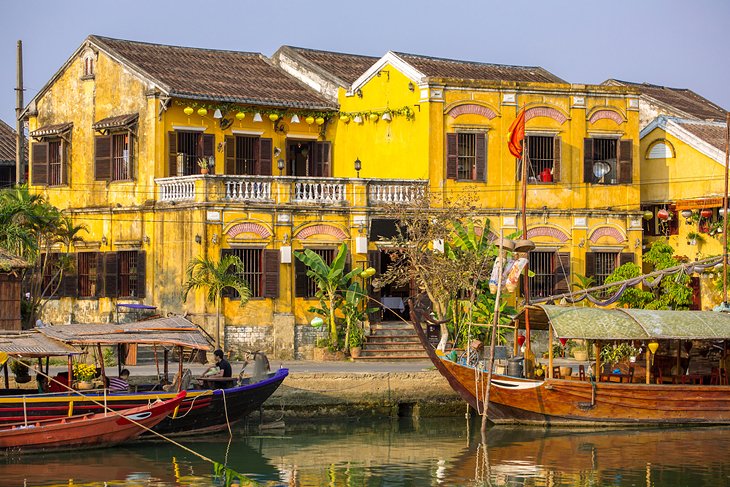
Beautiful Hoi An is the most atmospheric city in Vietnam, with bags of surviving historic architecture.
The old town quarter is a joy to explore, packed to the brim with well-preserved merchant houses that hark back to Hoi An's trading center heyday of the 15th century, when the town was a major meeting point for Japanese and Chinese merchants who flocked here for the local silks.
Plenty of the old merchant houses have been opened to the public, so you can get a taste of these times. The best is 17th-century Tan Ky House, with fascinating architectural and decorative elements.
Hoi An's major symbol is the delightful Japanese Bridge at the western end of Tran Phu Street, while nearby, the Assembly Hall of the Fujian Chinese Congregation is the old town's most highly decorated temple.
There are numerous small pagodas and museums dotted about town, but Hoi An's true charm is found in simply rambling the old town streets admiring the well-preserved facades.
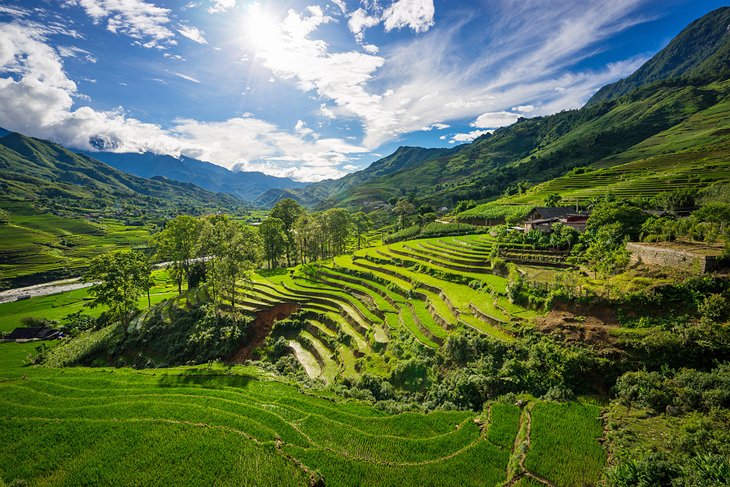
The verdant rice field countryside surrounding Sapa, bordered by the jagged peaks of the Hoang Lien Mountains (often still known by their French colonial era name of the Tonkinese Alps), are home to Vietnam's most beautiful rural vistas.
The deep valleys here are home to a diverse mix of the country's ethnic minorities, including the Hmong, Giay, and Red Dzao people, while the rippling hills are terraced with rice fields and overlooked by the country's tallest peak, Fansipan Mountain.
This is the top trekking destination in Vietnam with oodles of options to trek or day hike between tiny villages and experience the staggering mountain views.
Sapa itself is the main base here - an old hill station and now a bustling and forever growing tourist center that is a stark contrast to the sumptuous tranquil countryside right on its doorstep.
Author's Tip: Keen trekkers looking for more of northern Vietnam's lush mountain vistas may want to skip the busy Sapa scene completely and nudge further 95 kilometers northwest to Bac Ha , where the terraced hill views on hikes between hill villages are just as beautiful. Bac Ha's Sunday market is also a very popular day trip from Sapa.
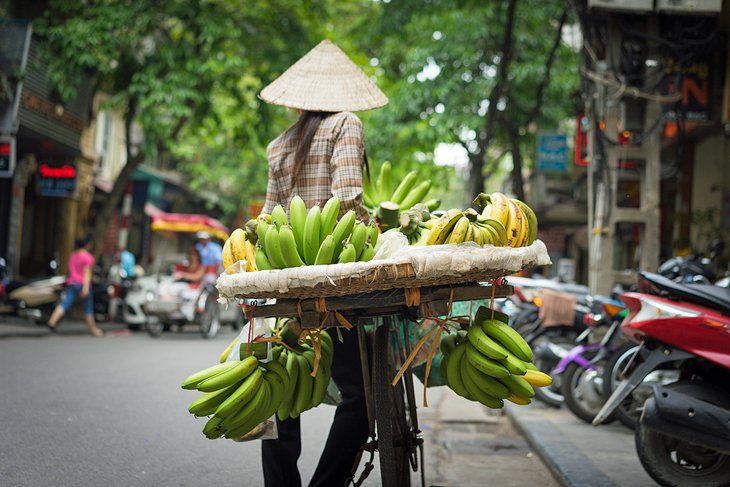
Vietnam's capital is the frenetic heartbeat of the nation and a place that befuddles travelers as much as it charms them.
The motorbike frenzy, pollution, and constant clamor of street vendors can get too much for some travelers, but if you want to dive into Vietnamese city life, Hanoi is the place to do it.
The old town quarter has plenty of dilapidated charm on offer, while history fans should make a beeline here simply to see the bundle of excellent museums.
The Vietnam Museum of Ethnology and Vietnam Fine Art Museum are both brilliant introductions to the diverse artistry of the country, while the Ho Chi Minh Mausoleum is an important tribute to the founder of modern Vietnam.
Author's Tip: It's well worth adding extra time into your itinerary to use Hanoi as a base for exploring the many sights within day tripping distance. In particular, the Tay Phuong and Thay Pagodas (30 kilometers west from the central city), Co Loa Citadel (24 kilometers northeast), and the Huong Pagoda (also known as the Perfume Pagoda; 60 kilometers southwest).
- Read More: Top-Rated Tourist Attractions in Hanoi
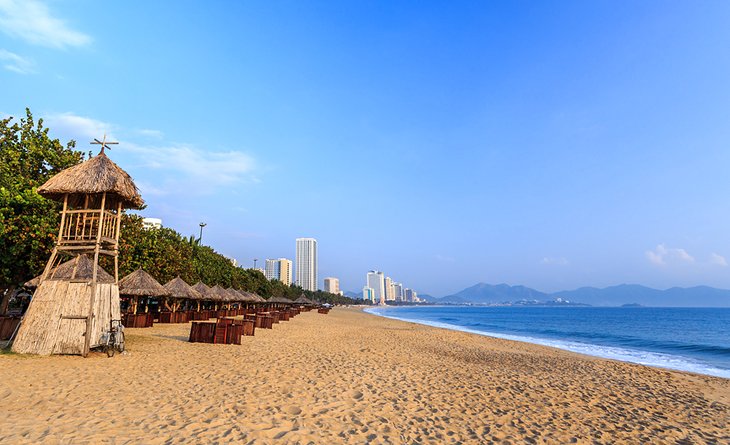
For sandy fun in Vietnam, Nha Trang is king. The well-maintained beach trundles for six kilometers along the shoreline of central Nha Trang city and during summer is jam-packed with local families on vacation, as well as foreign visitors.
There is excellent swimming here with designated swimming areas and manicured lounging areas that make this a great option for relaxing days soaking up the sun and sand.
If you do get bored of sunbathing, the ancient Po Nagar Cham Towers are just to the north across the Xom Bong Bridge and have been used as a place of worship here since at least the 7th century (with some historians saying the site itself has been a place of active worship since much earlier).
There is also an excellent museum dedicated to the work of Alexandre Yersin who discovered the cause of the bubonic plague and founded Nha Trang's Pasteur Institute (which still carries out vaccination programs in Vietnam today).
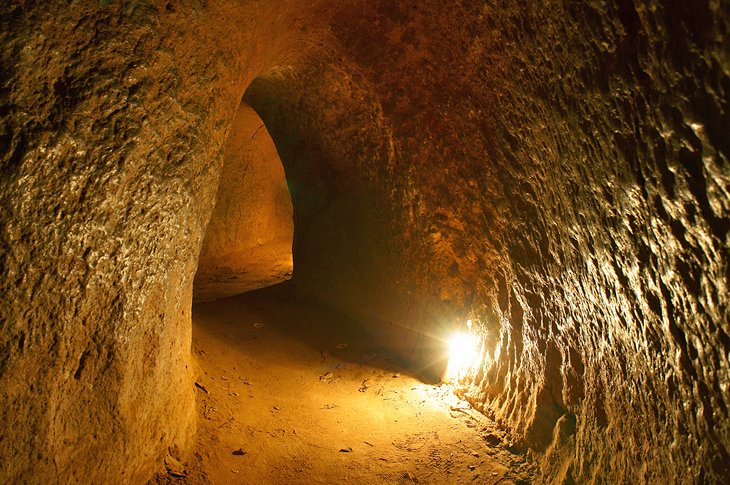
An absolutely fascinating experience for all travelers, not just those interested in Vietnam's modern military history, the Cu Chi Tunnels are an extensive tunnel network that during the war, stretched for more than 250 kilometers, allowing VC troops to operate and communicate in the area surrounding Ho Chi Minh City.
Two short sections of the network can be visited with a guide who'll take you down into the narrow unlit confines, which definitely are not for claustrophobia sufferers.
You will literally be crawling on your hands and knees and some points. You can access the tunnels at either Ben Dinh village (the more popular choice) or Ben Duoc village.
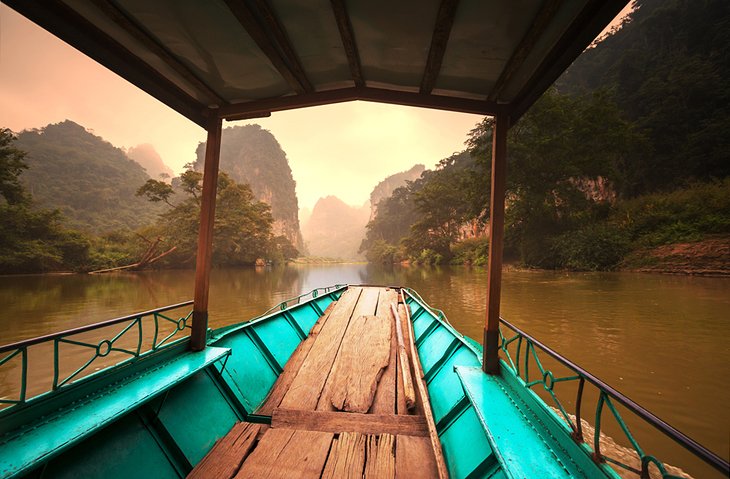
Tranquil Ba Be National Park is absolutely stunning with the three interlinked Ba Be Lakes at its heart, rimmed by jagged karst peaks and thickly forested slopes.
Most visitors come here to take peaceful boat trips or kayak on the lake and explore the caves full of stalactites and stalagmites in the vicinity, but for the more active, there's also excellent hiking and trekking in the hills here between ethnic minority villages.
This is one of the most peaceful spots in Vietnam, and travelers who spend the night here sleep in traditional stilt-house homestay accommodation along the lakeshore, allowing an experience of simple rural life.
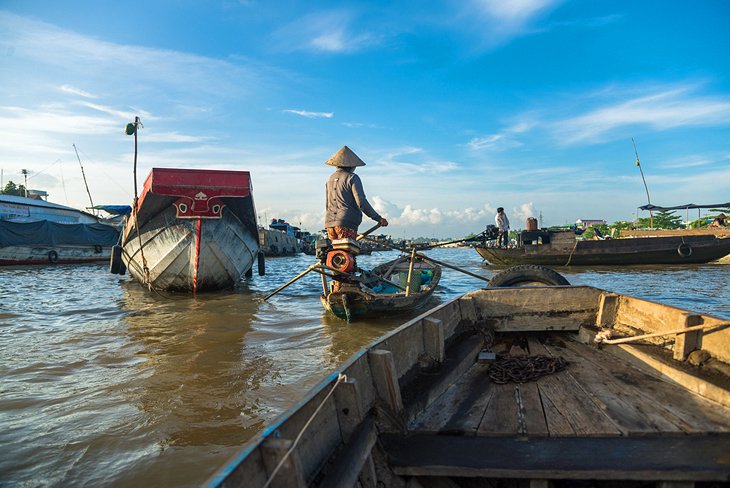
The far south of Vietnam is where the mighty Mekong River finally finds its way to the sea in a maze of waterways that crisscross the floodplain.
Incredibly lush, with paddy field vistas and mangroves, and full of local life, with chaotic floating markets to explore by boat, the delta is one of the most interesting regions for travelers to discover.
Can Tho is the most popular town to use as a base, as it's close to the floating markets of Phong Dien and Cai Rang, while boat trips from Ca Mau allow you to explore the U Minh Mangrove Forest and Cau Mau Nature Reserve.
This area of Vietnam is one of the best to visit for keen bird watchers and nature lovers , as it is home to both Tra Su Bird Sanctuary Forest and Bac Lieu Bird Sanctuary.
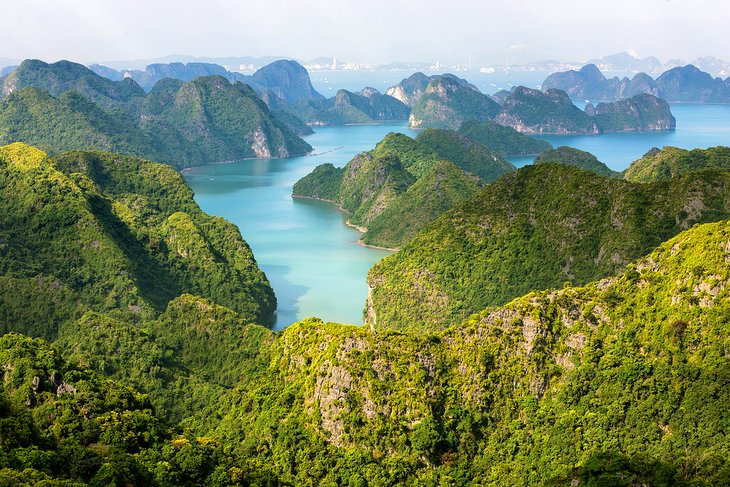
One of Vietnam's major centers for activities and adventure travel attractions, Cat Ba Island sits on the western edge of Halong Bay.
This is the best place to visit if you want to organize cruises and kayaking trips in Lan Ha Bay, which lies off Cat Ba's southern coast. Lan Ha Bay is a less visited seascape of karst islets and outcrops that makes for a quieter alternative to Halong Bay.
Off the water, much of Cat Ba's dense jungle interior is part of Cat Ba National Park, where hikers can spot plentiful birdlife, as well as animals such as macaques.
For many visitors, though, Cat Ba is all about climbing opportunities. Climbing excursions here utilize both the island's limestone cliffs and Lan Ha Bay's outcrops, providing experiences to suit both complete climbing beginners and experienced climbers.
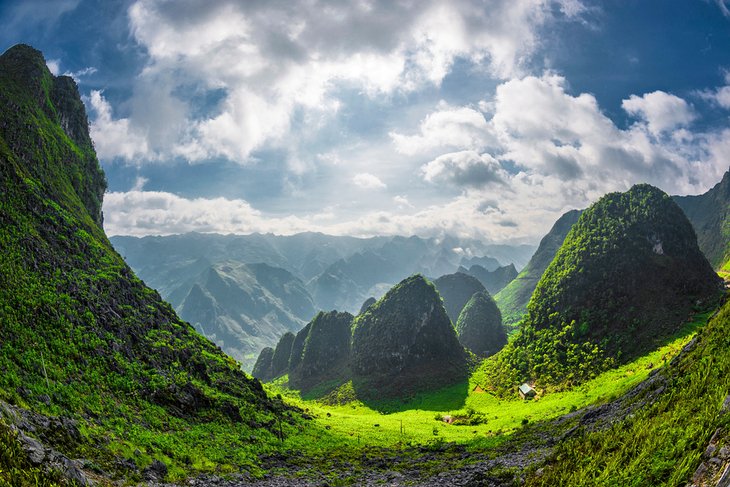
The emerald-green karst mountain landscapes along Ha Giang's mountain passes make this far-north province prime territory for scenic road-tripping by either motorbike or car.
In particular, the twisty Quan Ba Pass between Ha Giang town and Tam Son provides panoramic vistas of the karst plateau and its jagged limestone outcrops, while the zigzagging Mai Pi Leng Pass between Dong Van and Meo Vac offers dizzying views of the lush mountain scenery and narrow valleys below.
Time your visit to coincide with one of the area's market days, when traders from the surrounding mountain villages pile into town. Dong Van's Sunday market is one of the best.
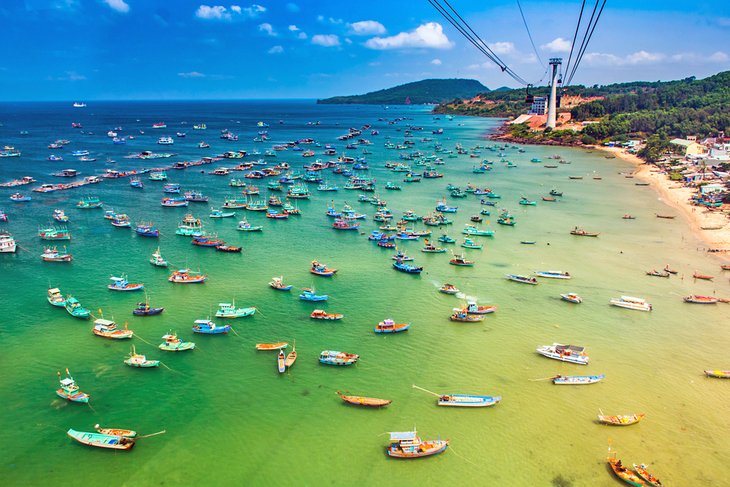
Sitting 45 kilometers off the southern coast of the country, in the Gulf of Thailand, Phu Quoc is a densely forested island, speckled by sweeps of white-sand beach that attract plenty of sunseekers during the winter dry season.
Dry season (November to May) is also when the island's underwater and on-the-water tourism attractions spring into action, with plenty of dive sites in the waters just offshore, as well as opportunities for snorkeling, kayaking, and boat trips.
Many of the main boat excursions head to the An Thoi Islands, just to the south of Phu Quoc, which is home to the best snorkeling in the area.
Off the water, the Phu Quoc cable-car provides bird's-eye views for eight kilometers, soaring over the seascape and islands, all the way from Phu Quoc to the island of Hon Thom in the An Thoi Islands.
Phu Quac is accessed by plane or regular ferries from the mainland towns of Rach Gia and Ha Tien. As Ha Tien lies very close to the southern border crossing with Cambodia, the island is a popular first (or last) stop-off in Vietnam for overland travelers.
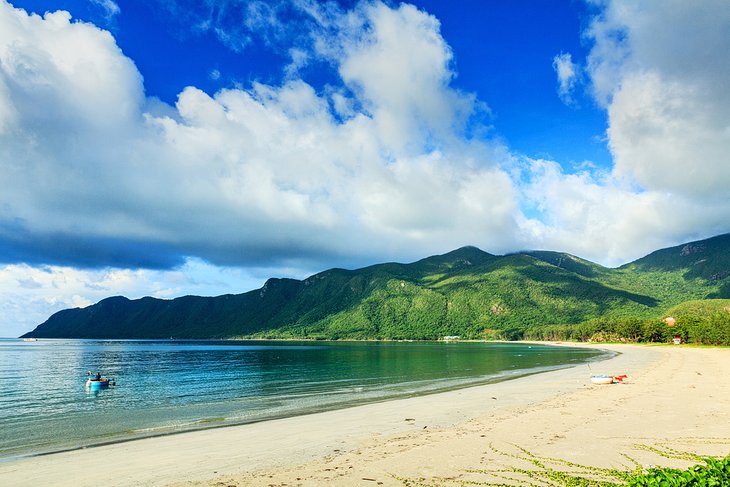
This remote island group lies around 160 kilometers offshore in the South China Sea and is renowned among divers as one of the best places to visit in the country, both for the variety of sea life and for the coral reefs.
Much of the Con Dao Islands, and the surrounding water, is a protected wilderness area, with the island shores home to nesting turtles, and dense forest still covering the island interiors.
The main island, and prime base for visitors with all the accommodation and things to do, is Con Son Island, which has sweeps of sand strung out across its coast that attract beachgoers looking for a relaxed sun-soaked getaway, as well as divers.
Even if you're here mostly for the beach, make sure to explore the historic sites of Con Son Town (the island's only settlement) including Phu Hai Prison, Bao Tang Con Dao Museum, and the prison known as the Tiger Cages, which document the dark history of this isolated island group.
Con Son's remote position led to the island being used to incarcerate political prisoners during the era Vietnam was occupied by French colonial forces, and later by both the South Vietnamese government and the occupying American forces.
Preserved sites including Phu Hai Prison and the prison cages used by the US forces, known as the Tiger Cages, along with Con Son Town's Bao Tang Con Dao Museum, do an excellent job of documenting this history for visitors.
Access to Con Son Island is either by flight from Ho Chi Minh City or by ferry from the coastal city of Vung Tau.
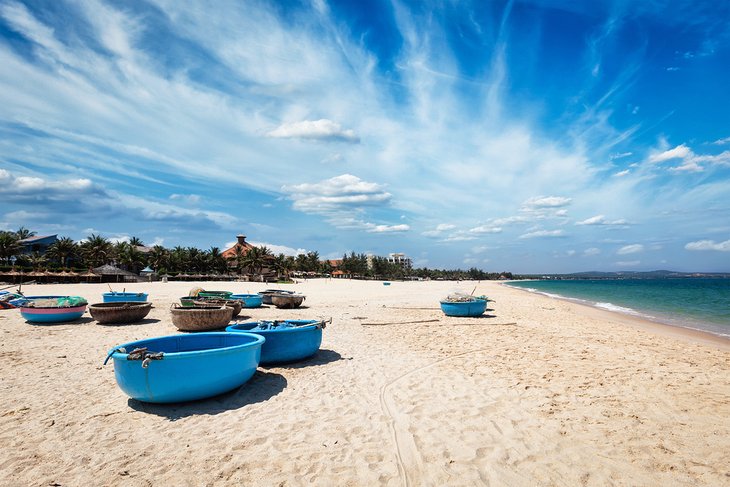
Once a sleepy coastal fishing town, Mui Né has developed into a beautiful beach resort town and a prime destination for windsurfing, sailing, and kitesurfing.
Compared to other beach destinations in Vietnam, however, Mui Né remains relatively unknown - and this means pristine beaches and a quiet retreat for most of the year.
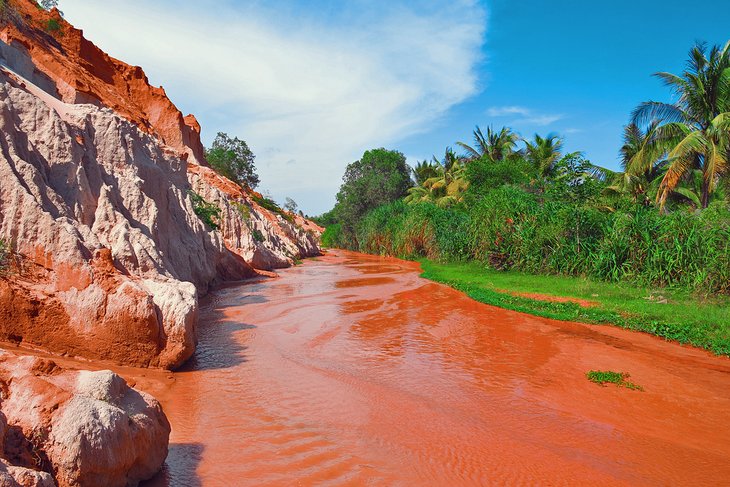
One of Mui Né's most unique attractions is the natural Red Sand Dunes just outside town, where visitors can practice sand-sledding or rent dune buggies for a more adrenaline-charged experience.
Tucked away between nearby fishing villages and towering orange limestone formations, there's the fairy stream, a slow-moving warm stream that almost feels like a walkway because it's so shallow - follow it to the end to reach a waterfall.
For those wishing to explore beyond the coastline, there are also the ruins of the Po Shanu Cham Towers - remnants of the Cham Empire that dominated the area many centuries ago.
Vietnam experiences strong monsoon seasons, where heavy rains hit the cities and the countryside, often causing floods and mudslides. If you're planning to travel around, the best time to visit Vietnam is during the dry season, which lasts from December to February – but there are some exceptions.
The south of Vietnam – where Ho Chi Minh city is located – experiences a more tropical climate, with high temperatures and high humidity year-round. Visiting these areas in the cooler months means less humidity and temperatures in the high 20s rather than the high 30s and 40s, which makes it more comfortable to walk around.
In the north, however, many areas experience an actual winter. Hanoi sees temperatures in the mid- to high teens in December and January – and in the mountains of Sapa in the north, you'll even get to see some snow during these months.
If you're visiting Danang for some beach time or to travel through the ancient town of Hoi An, it's best to arrive between February and May, when water and air temperature are in the 20s – perfect beach weather for enjoying the sand or a dip in the water. The rainy season, and especially the months of September and October, see very heavy rains and often very strong wind storms on the coast, so it's better to stay away from Danang during this time.

More on Vietnam
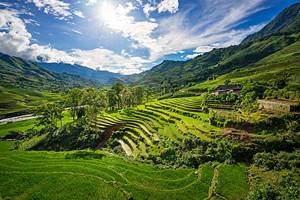
The 15 best things you can do in Vietnam in 2024

Feb 29, 2024 • 11 min read

Taking a cruise along the Mekong Delta is an incredible experience not to be missed © Cultura Exclusive / Rosanna U / Getty Images
The siren song of Vietnam has brought many travelers to its shores in search of incredible landscapes, pearl-white beaches , chaotic and vibrant cities, and one of the warmest welcomes in the world.
The tough decision for travelers isn't whether they should visit Vietnam, it's how they choose what to do with so many incredible options. Do you start in Hanoi or Ho Chi Minh City (HCMC)? Do you swap the big city experience for the beaches and seafood suppers of Phu Quoc island? Do you dive headlong into the history of a dozen rival empires, or embrace the dynamic, modern Vietnam that has emerged from the aftermath of conflict?
No matter what you want your vacation to look like, accept that you'll never cover everything in one trip and embrace it as a reason to return. Here are 15 incredible things to do that need to be on your Vietnam to-do list.
1. Embrace past and future Vietnam in historic Hanoi
The vibrant capital of the former North Vietnam – and today the capital of the nation – Hanoi is where old and new Vietnam come together. Traces of the imperial past float like ghosts in a city surging skywards – hawkers drift through the narrow lanes of the Old Quarter selling snacks from traditional yoke baskets, while the surrounding buildings are lit up with advertising displays and strip lights.
Exploring at street level is highly atmospheric and fantastic fun – mix up days visiting wartime and imperial relics with evenings feasting on some of Asia’s finest food and late nights dousing the sticky summer heat with glasses of bia hoi (local draught beer).
Planning tip: As they say, Hanoi rocks, and the best places to rock out like a local are lively live music venues such as the moody Binh Minh Jazz Club and keep-it-loud Hanoi Rock City .
2. Find your own island in the sun in Halong Bay and Bai Tu Long Bay
Okay, we concede that Halong Bay – the atmospheric sprawl of rocky coves and eroded karst islands to the east of Hanoi – is firmly discovered, but that doesn’t mean there isn’t more to discover away from the cruise ship crowds. If a tour on a diesel-powered luxury junk doesn’t appeal, consider hiring a kayak to potter around Lan Ha Bay near Cat Ba Island , where outcrops sculpted by wind and waves emerge from the water like the teeth of sea monsters.
Alternatively, leave the diesel fumes behind in calmer Bai Tu Long Bay to the north, where more jungle-capped islands shelter low-key resorts and languorous beaches.

3. Get your fill of imperial cuisine in handsome Hue
Vietnam’s Nguyen Dynasty held court in Hue until 1945, and the city’s damaged but still impressive historic relics feel somehow closer to imperial China than to the rest of Southeast Asia. However, for many travelers, it’s all about the food. More than half of Vietnam's estimated 3000 local dishes are believed to have originated in Hue, from the vermicelli-noodle-based bun bo Hue and crispy banh khoai pancakes topped with shrimp and pork to canapé-like, soft-and-crunchy banh ram it dumplings. The lavish imperial cuisine known as am thuc cung dinh – created by the emperors’ loyal chefs – can still be sampled in some of Hue's top restaurants, such as Thin Gia Vien and Hoang Phu .
Planning tip: Don’t restrict yourself to posh imperial banquets; for less than 100,000 dong you can gorge on tasty Hue staples at busy stalwart restaurants such as Madam Thu or at food stalls on the streets.
4. Meet Vietnam’s imperial leaders in the Hue tombs
Hue gets a second spot on the list thanks to the astounding imperial tombs, which preserve the mortal remains of a string of Nguyen emperors and empresses, from dynasty-founding Gia Long to Khai Dinh , the last Nguyen emperor to be buried on Vietnamese soil (his son, Bao Dai, the final emperor of Vietnam, was interred in the Cimetière de Passy in Paris ).
While crowds mob the Citadel and Imperial Enclosure, you can still find peaceful moments for contemplation by skipping the boat tours and renting a motorcycle to visit the extravagant mausoleums along the Perfume River. Don’t miss the towering Thien Mu pagoda , looming over the north bank on the city fringes.
Detour: Equipped with two wheels, you can also buzz north from Hue to enjoy unspoiled dune beaches on the sandy barrier island stretching north and south from Thuan An.
5. Learn to make soups, stir-fries and salads on a cooking course
There’s no better souvenir to bring home from Vietnam than being able to prepare your own Vietnamese feast. Indeed, Vietnamese food arguably has a bigger dinner-party cachet than more familiar Thai cuisine.
Up and down the country, you’ll find cooking courses that start with a fragrant market trip to buy fresh ingredients and local herbs and end with a banquet of the dishes you’ve prepared, covering everything from summer rolls to pho noodle soup.
Hoi An is the most popular destination for aspiring chefs – small and personal Green Bamboo Cooking School is highly recommended. There are also good cooking schools in Hue, Hanoi and HCMC.

6. Unravel Vietnam’s complex religious history in My Son
While travelers mob the regal assembly halls, pagodas and historic homes of Hoi An, nearby My Son offers a calmer vision of Vietnam’s rich and layered past – particularly if you come in the afternoon. The big lure here is the atmospheric collection of UNESCO-listed Hindu temple ruins surrounded by jungle in a loop of the sacred Thu Bon river.
Sharing many architectural features with the Khmer temples of Cambodia and Thailand , these crumbling, red-brick shrines were built between the 4th and 14th centuries by the Hindu kingdom of Champa, whose descendants – the Cham people – can still be found in pockets in central Vietnam. With only birdsong to disrupt the quiet, the site scores highly for atmosphere as well as history,
Detour: If you use Hoi An as a base for exploring My Son, set aside a day to explore the nearby Cham Islands , an impressive marine reserve whose granite islands are still inhabited by Cham people, most now followers of Islam.
Explore My Son effortlessly with GetYourGuide. Book your tour today .
7. Visit the Cao Dai Holy See in Tay Ninh
One of the world’s youngest faiths, the Cao Dai religion was founded in the Mekong Delta town of Tay Ninh in 1926, fusing elements of ancestor worship, folk religions, Confucianism, Taoism, Buddhism and Roman Catholicism, with the ultimate goal of freeing the soul from the endless cycle of reincarnation.
To explore its complex customs, head to the cathedral-like Cao Dai Holy See in Tay Ninh. Inside, you’ll see weapon-toting statues, an all-seeing eye, and even a Communist-looking red star – the sect reveres, amongst other figures, Jesus Christ, Buddha, Mohammed and even French novelist Victor Hugo.
Planning tip: Visitors can enter the shrine to witness prayers four times a day; if you have time to kill before or after a visit, detour 15km (9.3 miles) northeast to Nui Ba Den mountain. You can take a gondola then hike to reach its summit cave temples, then whoosh back downhill on a luge-style slide.

8. Rumble through the highlands by motorcycle
Vietnam largely moves on two wheels, and a motorcycle is by far the most enjoyable way to explore the hill country of the northwest , even if it takes some courage to adjust to the driving conditions, the errant livestock, and the steep, winding roads. Rent a quality bike in Hanoi and pop your wheels on the train to Lao Cai, to avoid the nerve-jangling ride out of the capital.
Once you reach the heart of the hill country, you can rumble out to outlying villages far from the tourist crowds for epic views and nights in charming homestays run by members of Vietnam’s tribal minorities.
Planning tip: You’ll need an international driving permit to ride legally in Vietnam, and this is only available for some nationalities. Many travelers manage to rent a motorcycle without a permit, but if things go wrong, you won’t be covered by your travel insurance.
9. See the American War through Vietnamese eyes
Modern-day Vietnam is moving on from conflict, but the battlefields from the American War still linger as a sobering reminder of what people had to go through to get to this point. Sites of American losses such as Hamburger Hill in the Demilitarized Zone (DMZ) are etched into the popular consciousness, but the wartime tunnels at Cu Chi near HCMC and Vinh Moc near Hue offer a glimpse of the Vietnamese experience, as ordinary people went to extraordinary lengths to resist the world’s greatest superpower.
10. Visit villages in the "Asian Alps"
The former French Hill station of Sapa is surrounded by mountains so impressive that French colonizers called them the “Tonkinese Alps,” and the surrounding villages of the H'Mong and Dao ethnic minorities have become popular destinations for hikers – and somewhat commercialized in the process.
For a taste of the scenic serenity that first drew travelers to these lush green hills, head instead to drier, calmer Bac Ha , or the trails and mountain roads around Ha Giang province, tucked against the border with China and seemingly sculpted by the hands of the gods. Stay in hospitable homestays and explore markets, peaceful stilt-house villages, French-era relics and soaring limestone pinnacles, away from the maddening crowds.
Planning tip: There's a lot of competition for the title of best vista in Vietnam but the lookouts gazing over the Dong Van Karst Plateau are strong contenders. The area is designated as a UNESCO Geopark, and the trip from Yen Minh to Dong Van and over the Mai Pi Leng Pass to Meo Vac is particularly spectacular.
11. Find a perfect cup of coffee in the Central Highlands
It was the French colonizers who brought coffee from the Arabian peninsula to Vietnam, but it was the farmers of the Southwest Highlands who mastered the art of coaxing quality beans from these undulating hills. Rising to 1600m (5250ft), Dak Lak Province provides the perfect terroir for growing robusta beans, and the regional capital of Buon Ma Thuot is a great place to tour plantations and track down a quality cup of ca phe , particularly during the annual coffee festival in March. If you insist on arabica beans, head to Dalat and visit the community K'Ho Coffee cooperative, supporting local coffee growers from the K’Ho minority.
Planning tip: The best time to visit coffee country is from September to the end of December when the harvest season is in full swing and plantations are filled with baskets of red beans.
Transform your visit the Central Highlands by booking with GetYourGuide.

12. Enter the world’s largest cave in Phong Nha
Phong Nha-Ke Bang National Park in north central Vietnam is a lost world of jungles and caverns, including the world’s largest, Hang Son Doong. The scale of this wonder of nature is simply mind-blowing – a 747 airplane could fly through the cave’s main tunnel.
Parts of the limestone ceiling have collapsed, bringing in natural sunlight, so Hang Son Doong contains an entire rainforest ecosystem with flying foxes, rare langurs, and even a small population of tigers. Since 2012, one tour company – Oxalis Adventure – has been allowed to take a strictly limited number of visitors into Hang Son Doong on challenging four-day treks; the price is stratospheric but so is the scenery.
13. Walk with the ghosts of French Indochina in Ho Chi Minh City
The former capital of South Vietnam may have changed its name from Saigon to Ho Chi Minh City (HCMC) , but the past remains close to the surface, from the American War relics in the HCMC Museum and War Remnants Museum to the city’s elegant French-built mansions and civic buildings – many now housing museums, restaurants and boutique hotels.
To get a feel for vintage Saigon, stop for a cup of ca phe sua (milk coffee) at the elegant Hotel Continental Saigon , sample cutting-edge French cuisine at La Villa , and take a stroll past the Central Post Office, Notre Dame Cathedral and the People’s Committee Building – built as HCMC’s Hôtel de Ville but rebranded as the Vietnamese sent the colonizers packing.
Planning tip: To fully appreciate the marvelous, lip-tingling variety of HCMC street food, join a foodie-focused scooter tour with Saigon Street Eats .
Explore Ho Chi Minh City effortlessly with GetYourGuide. Book your tour today .
14. Bask on beautiful beaches
It was the beaches of Phu Quoc Island and Danang – developed as a playground for GIs during the American War – that put Vietnam on the map for seaside vacations, but both have developed into lively resorts. To find unspoiled stretches of sand, modern-day castaways aim their sights at the kitesurfing beaches around Mui Ne , the island sands of the Con Dao archipelago and long, languorous Hong Van Beach on Co To Island in Bai Tu Long Bay .
Planning tip: The best time for a beach trip varies as you move around the country. In central Vietnam, skies are brightest from January to August, while December to April is the beach window on the south coast, and northern Vietnam sees plenty of dry days from October to April.
15. Float on the Mekong Delta
Reaching out into the East Sea like an enormous hand, the mighty Mekong Delta marks the end point of Southeast Asia’s longest river – a 4350km (2700 mile) monster, rising on the Tibetan plateau and emptying to the south of Ho Chi Minh City. This waterlogged wonderland is Vietnam’s rice bowl, nurturing a network of sleepy towns and stilt villages whose residents use the river as their primary artery for life and trade.
For comfortable exploring, book an overnight cruise along the main channel near Can Tho or a cross-border trip to Siem Reap in Cambodia. For a less commercial experience, take a day trip to the backwaters near Ben Tre with Mango Cruises or make your own arrangements with boat owners in Delta villages.
Explore related stories

Sep 23, 2024 • 8 min read
Ho Chi Minh City is fast-paced and fabulous, but brilliant day trips await nearby in the Mekong Delta. Here are our top day trips from Ho Chi Minh City.

Aug 30, 2024 • 9 min read

Aug 21, 2024 • 7 min read

Aug 20, 2024 • 13 min read

Aug 20, 2024 • 6 min read

Aug 16, 2024 • 8 min read

Jul 12, 2024 • 5 min read

Jun 17, 2024 • 12 min read

May 23, 2024 • 7 min read

Feb 19, 2024 • 6 min read

Touropia Travel
Discover the World
17 Best Places to Visit in Vietnam
By Spencer Leasca · Last updated on August 18, 2024
A long, narrow country squeezed in between the South China Sea and the Laos and Cambodia borders, Vietnam is a land of striking landscapes that range from the lush rice terraces and forested mountains in the north to the picturesque valleys of the Central Highlands and the fertile delta and beautiful beaches of the south.
Vietnam has seen its fair share of struggles. Ruled for almost a thousand years by various Chinese dynasties until 938 AD, Vietnam became a French protectorate in the 19th century. After independence, there was the Vietnam War.
Today, Vietnam is a proud country and you can see why. Not just for fiercely defending its own independence, but for its incredible landscapes and history.
The first words on everyone’s lips when speaking of Vietnam are undoubtedly Halong Bay, a beautiful set of karst islands and formations off the northern coast. Hanoi is the bustling, motorbike filled capital. Plan your trip to this beautiful Southeast Asia travel destination with our list of the best places to visit in Vietnam.
17. Da Nang
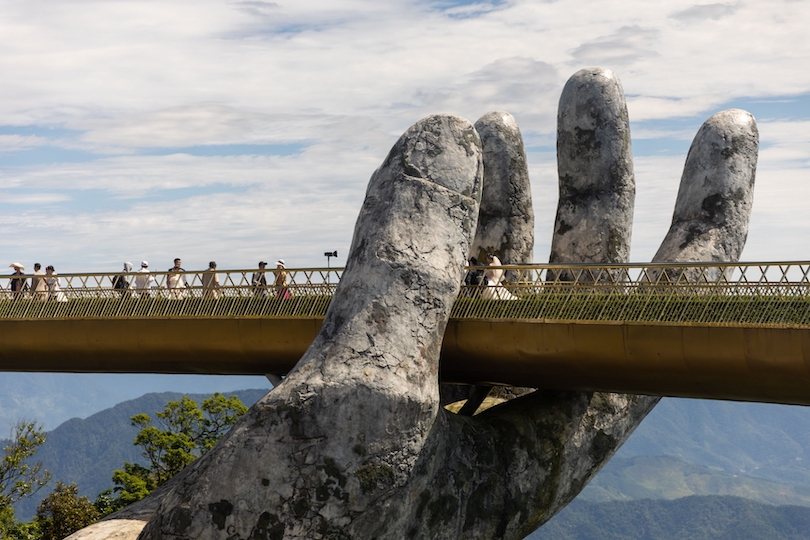
Nestled on the central coast of Vietnam, Da Nang is an energetic coastal city with a historic French colonial port.
It is known primarily for its fantastic beaches, including the famous My Khe Beach , which Tripadvisor has named as one of the best beaches in Asia.
However, it is also a popular starting point for exploration of the Bà Nà hills , which lie on the city’s western reaches. From there, the spectacular Hải Vân Pass showcases incredible views of Da Nang Bay. Moreover it conveys the Marble Mountains , five imperious limestone outcrops crowned with ornate pagodas and yield caves containing lavish Buddhist shrines.
Da Nang boasts impressive landmarks like the iconic Dragon Bridge , world-class golf courses, and a modern skyline dotted with luxury resorts and upscale shopping centres.
The city is also home to many cultural experiences, including the Da Nang Museum of Cham Sculpture and Da Nang Fine Arts Museum.
16. Ha Giang Loop
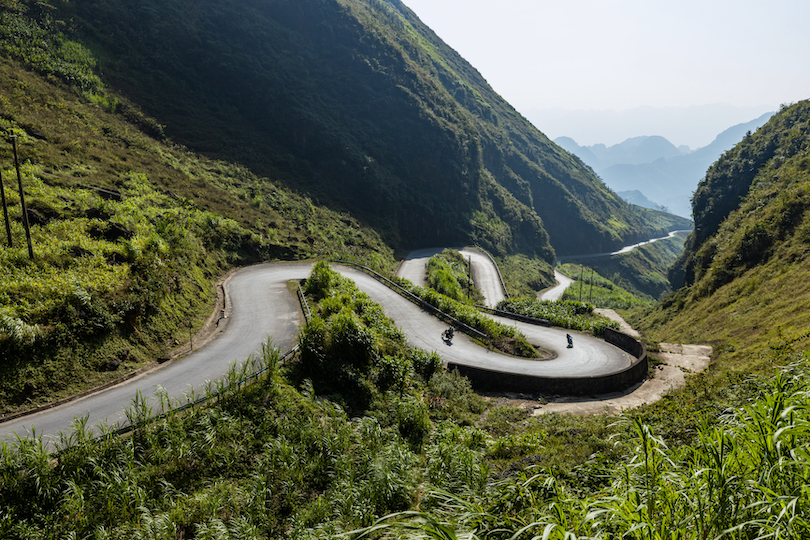
If you pride yourself on being an adventurous traveler, then you should embrace the Ha Giang Loop with open arms.
Located in the remote and breathtaking Ha Giang province , tourists can embark on a thrilling motorbike journey through some of the country’s most awe-inspiring landscapes. This scenic loop takes you on a winding road that cuts through majestic mountains, lush valleys and terraced rice fields.
The journey provides an immersive experience, allowing you to connect with the authentic culture of the ethnic minority communities that call this region home.
Along the way, you’ll encounter traditional villages , where locals showcase their rich heritage, colorful attire, and warm hospitality.
The loop offers stunning viewpoints such as Ma Pi Leng Pass , with its jaw-dropping vistas of the Nho Que River snaking through the mountains. You can also visit attractions like Dong Van Karst Plateau, a UNESCO Geopark, and the fairy-tale-like Lung Cu Flag Tower.
Typically, this journey takes three to four days to complete. Its rugged beauty and remote nature are perfect for those seeking an off-the-beaten-path experience.
15. Bai Tu Long Bay
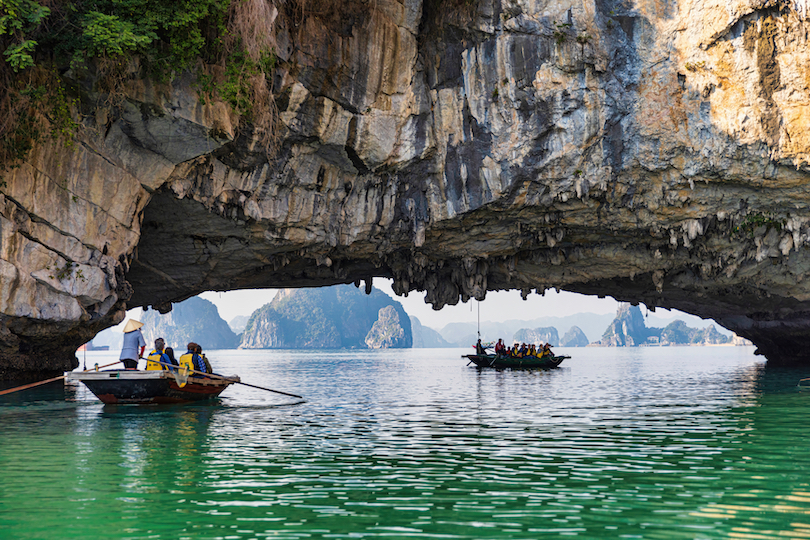
If you can’t get to or don’t fancy visiting Halong Bay, Bai Tu Long Bay is an excellent alternative. Situated in the northeastern part of Vietnam, it has all the pristine beauty and untouched landscapes of its more illustrious neighbor, only with greater tranquillity and fewer crowds.
The picturesque bay is characterized by its emerald waters, towering limestone islands , and lush vegetation. Cruising through it provides fabulous opportunities for kayaking , swimming and visiting remote fishing villages.
The bay is also home to a diverse ecosystem accommodating rare wildlife, colourful coral reefs and hidden caves waiting for you to discover them.
A tour of the area allows for a more intimate connection with nature and a chance to experience the serenity of the surroundings. Whilst there, be sure to visit the incredible Thien Canh Son Cave . One of 59 discovered caves in the area, it will wow you with its unique stalactite formations.
14. Tam Coc
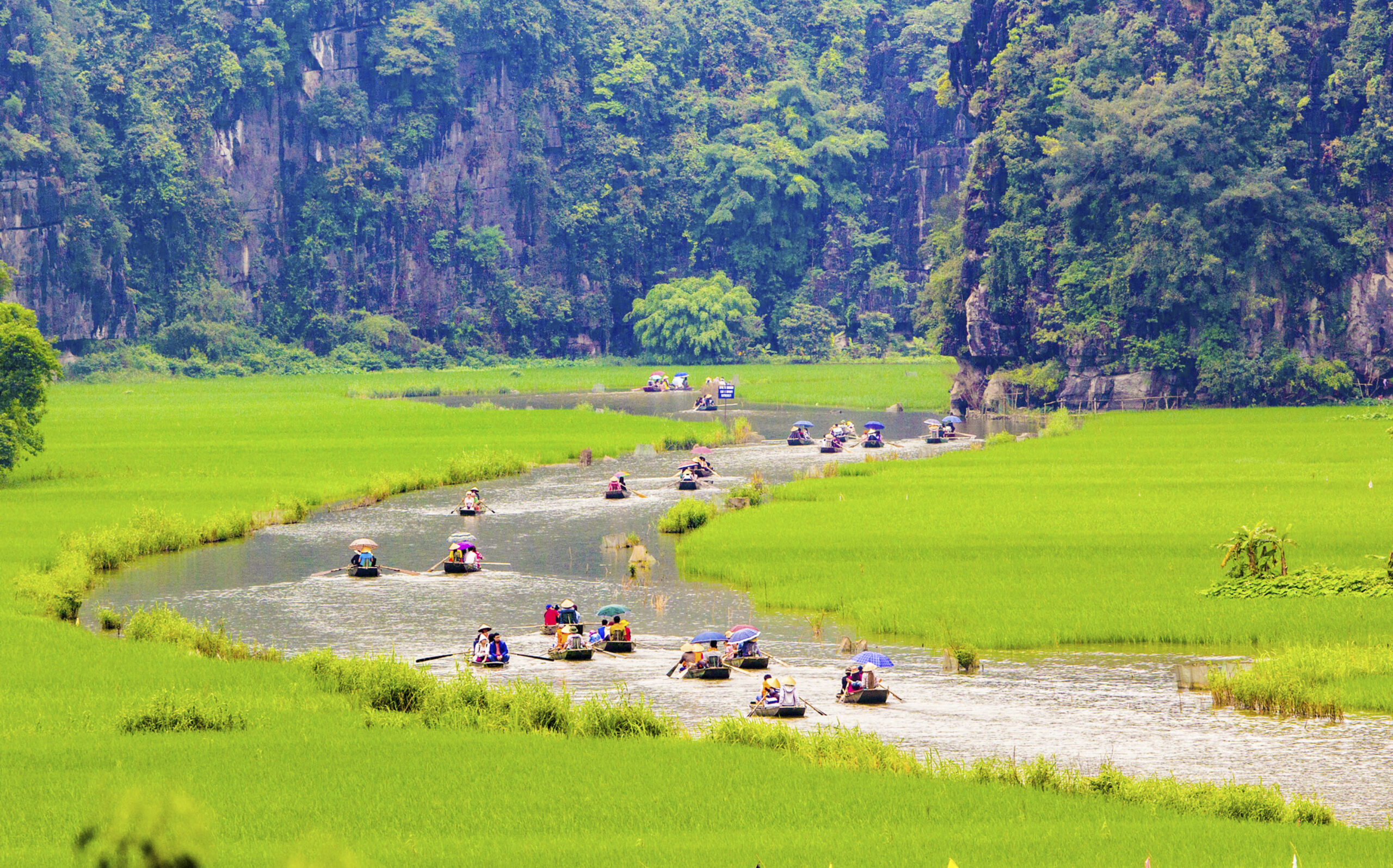
Tam Coc, often called ‘ Halong Bay on land ‘, is an enchanting destination in the Ninh Binh province.
Forming part of the UNESCO World Heritage Tràng An scenic landscape site, it is renowned for its dramatic limestone karsts that dramatically rise out of emerald green rice fields. Tam Coc presents visitors with a stunning natural landscape that will forever leave an impression on their heart.
The main attraction in Tam Coc is a scenic boat ride along the Ngo Dong River , where local rowers skilfully navigate through a series of caves and limestone formations. As you glide along the tranquil waterways, you’ll be mesmerized by the picturesque scenery and the harmonious blend of nature and verdant rice paddies.
Tam Coc is also home to ancient temples and pagodas, such as Bich Dong Pagoda , which is perched atop a hill and offers panoramic views of the surrounding countryside.
If you are into cycling, you can also explore the area in more detail on two wheels.
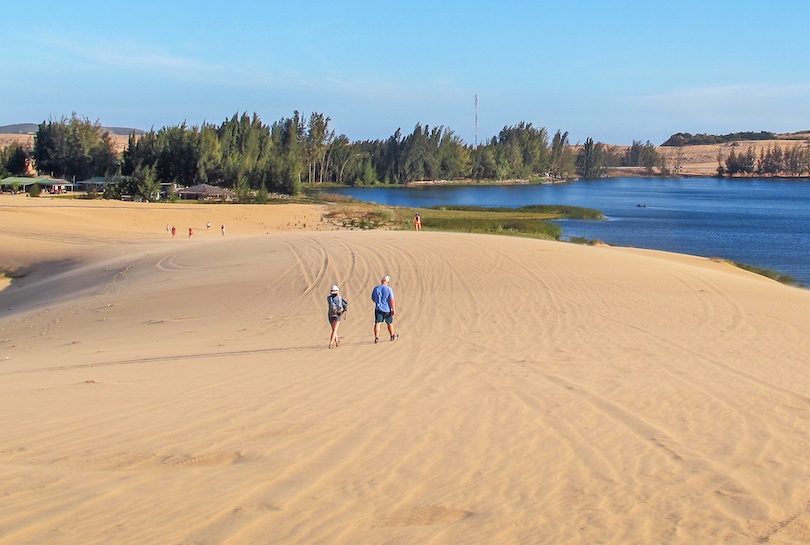
There are several places in Vietnam where you can go for some beach R&R, but few can compare to the sheer beauty of Mũi Né.
A stunning beach resort town along the southeast coastline, it boasts a long stretch of golden palm-tree-lined sand, perfect for walking and sunbathing. During the dry season, with steady wind conditions, the area becomes a fantastic destination for sailing, kitesurfing and windsurfing.
The highlight of Mui Né is undoubtedly its captivating sand dunes . The iconic White Sand Dunes and Red Sand Dunes offer a surreal landscape that resembles a desert oasis. On our last visit, we explored the dunes on an ATV ride and sand boarded down the slopes. Both were a lot of fun!
Beyond the beaches and dunes, Mui Né offers opportunities to explore nearby fishing villages , taste delicious seafood, and indulge in rejuvenating spa treatments. Close by, The Fairy Stream, with its gently flowing water and unique rock formations, is a popular spot for a refreshing dip on a stiflingly hot day.
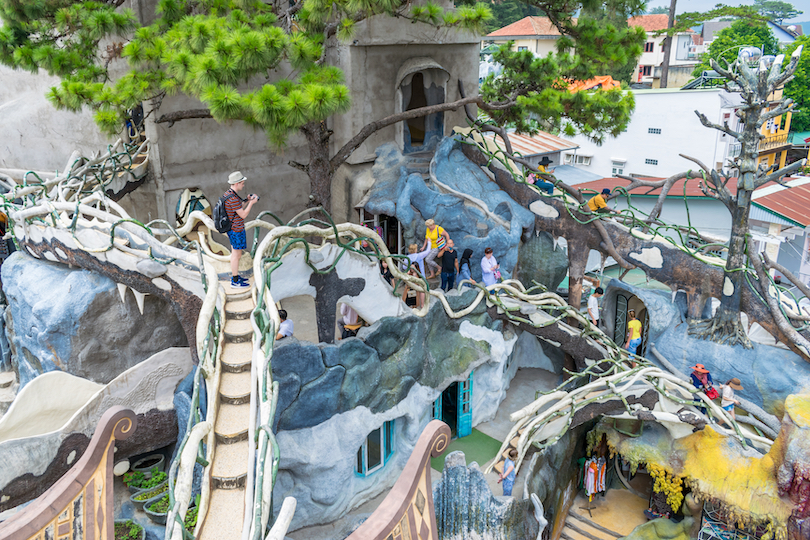
Year-round cool weather and idyllic scenery of misty valleys, lush pine trees and colorful flowers are some of the reasons that Dalat was once used by Vietnamese emperors and French colonials as a summer retreat. Today, this charming town in the South Central Highlands of Vietnam is a popular destination for honeymooners, weekend getaways and for those looking for relief from the heat.
A walkable city, Dalat is a beautiful scene of French colonial architecture and villas set amid picturesque landscapes. The city is well known for its royal palaces that were owned by the last emperor of Vietnam. These lovely palaces are open for tours as is the Hang Nga Guesthouse, the city’s most bizarre attraction. Informally called the “Crazy House,” this structure is a fantastical construction with caves, spider webs and shapes of animals and mushrooms.
Dalat’s lively market is a great place to find fruits, flowers and vegetables grown in the local area as well as handicrafts and silk embroidered items.
Outside the city are scenic lakes, flower gardens, plantations and mountains offering pretty waterfalls and trails for hiking and mountain biking. A must-do is the Valley of Love, an incredibly beautiful valley with pine forests and lakes where tourists can enjoy pedal-boating and canyoning.
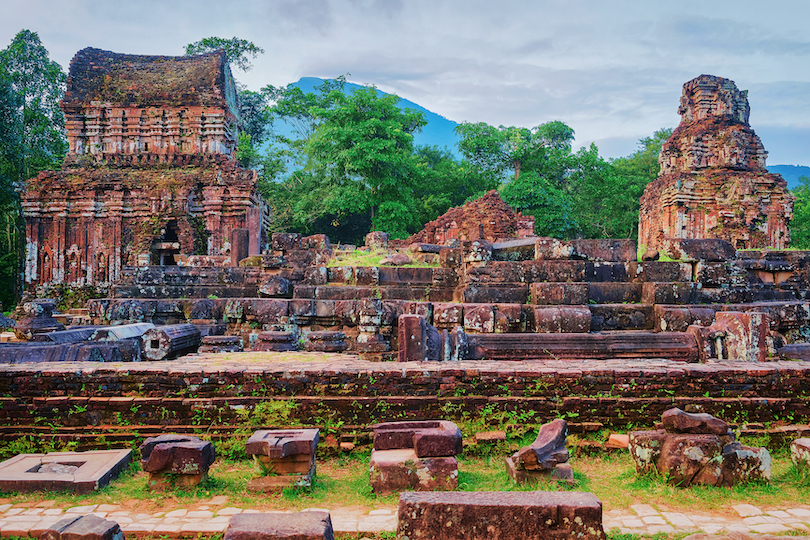
Located on the central coast of Vietnam near the Duy Phú village is the important archaeological site known as My Son . One of Southeast Asia’s most notable heritage sites, My Son was once a significant center of religious Hindu ceremonies where the kings of the Champa Kingdom built numerous temples devoted to the worship of the god, Shiva, between the 4th and 14th centuries.
Believed to have once contained more than 70 temples that were constructed with brick and decorative carvings and sculptures bearing scenes of animals, priests, gods, mythical battles and inscriptions of Sanskrit and Champa, My Son today features a complex of ruins in varying states of disarray and repair, all arranged in several groups.
Within the site is a museum where visitors can check out exhibits and artifacts to better understand and appreciate the ruins. Near the entrance of My Son are a few cafes, food vendors and a shop selling souvenirs. At certain times of the day, visitors can watch live Champa dance performances. Additionally, the site is surrounded by jungle, hills and a lake where visitors can enjoy hiking and kayaking.
My Son is often reached by organized tour groups from Hoi An. However, visitors can also arrive at My Son by motorbike rentals.
10. Phu Quoc
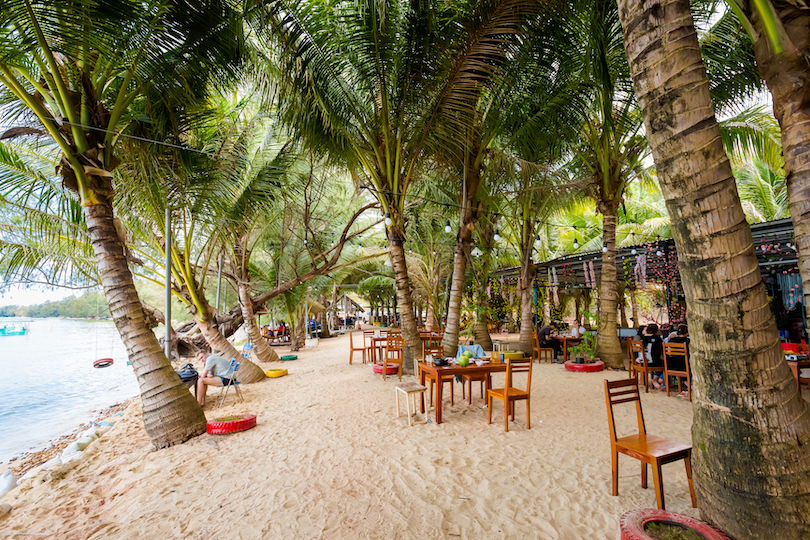
Phu Quoc is a scenic island in the Gulf of Thailand. While it officially forms part of Vietnam, it is actually closer geographically to Cambodia . Today, it’s characterized by dense tropical jungle, soft sandy beaches, and undulating hills. But the island has a fascinating history, having served first as a French missionary base and then as a French colonial wartime prison – a gloomy reformatory that you can visit today.
History aside, the island is most tempting for its alluring tropical nature . Days in Phu Quoc are spent sunbathing on sandy beaches, scootering around fishing villages, visiting pearl and pepper farms, and, if you’re up for it, trekking to waterfalls.
An island that’s famous for its seafood, don’t miss an opportunity to try out Phu Quoc’s famous fish sauce (nuoc mam) – you can even visit one of the fish sauce factories while you’re here!

9. Phong Nha-Ke Bang National Park
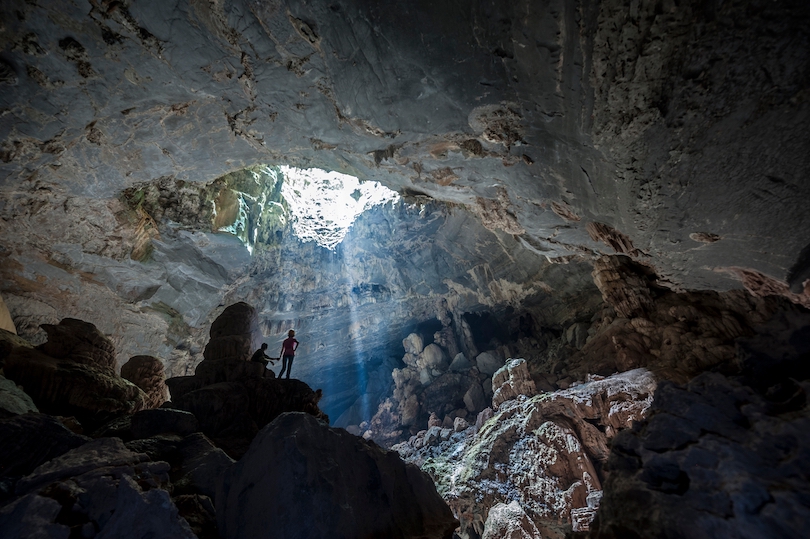
Tucked away in the Quang Binh Province in Vietnam’s Central Coast region, Phong Nha-Ke Bang National Park is one of the most picturesque parts of the country. With a steadfast reputation as a filming location for 2017 Kong: Skull Island, and with a nearby international airport, the national park is more popular than ever before.
Opened to the public in 2010, the appeal of Phong Nha-Ke Bang National Park is the escape from the city. Here, you’ll live life in the slow lane as you cycle through Kong jungles at your own pace.
Home to 400 million-year-old karst mountains, there are hundreds of caves and secretive rivers to explore. The Son Doong Cave is a must visit. Home to its very own hidden jungle, microclimate, and Underground River, it’s one of the largest caves on Earth .
Due to its location near the Laos border, access to the park is strictly controlled, and visitors can expect to find a strong military presence here. This is mainly due to its war history – the park has some of the world’s highest numbers of undetonated bombs, which is why visitors can only visit this place with a licensed tour guide.
8. Ho Chi Minh City
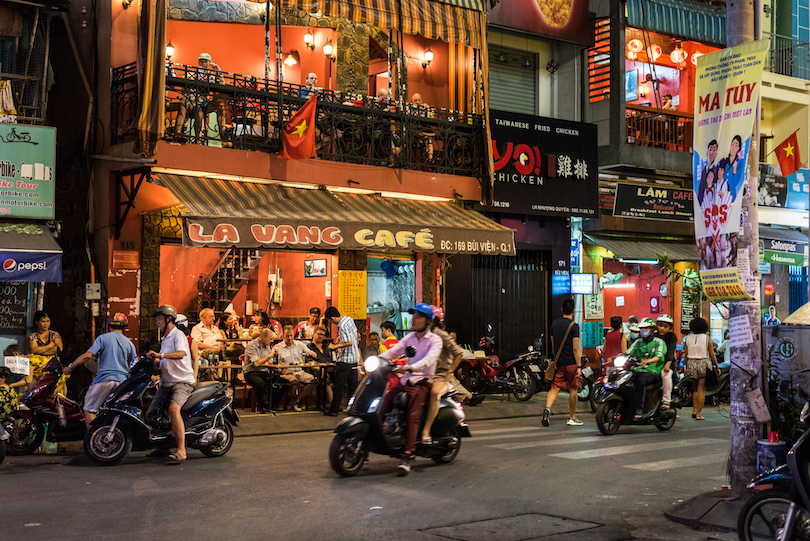
Ho Chi Minh, formerly known as Saigon , is the biggest city in all of Vietnam. It’s also the old capital of the Republic of Vietnam. When Saigon fell to the north in 1975, it was renamed to HCMC, yet its former name is still used today, particularly when describing the beating heart of the city.
Hoi Chi Minh has a bit of everything – temples, museums, parks, and tourist shopping. Whatever your interests, you’ll find something to do here. Head to the top of the Saigon Skydeck for an astonishing 360-degree view of the city – especially impressive at night when the lights twinkle on below.
History buffs should not miss the chance to explore the mysterious network of the Cu Chi tunnels , the headquarters for many military operations during the Vietnam War.
The five stories of Reunification Palace – also known as the Independence Palace – is also a fascinating place to go. It’s a famous spot in Vietnam’s history as it captures the time when Saigon fell as a tank broke through the gates of the palace. A replica of this same tank can be seen on the grass outside the palace.
If you’re curious to learn more about the war, you’ll enjoy a visit to the War Remnants Museum or the Museum of Vietnamese History.
7. Mekong Delta
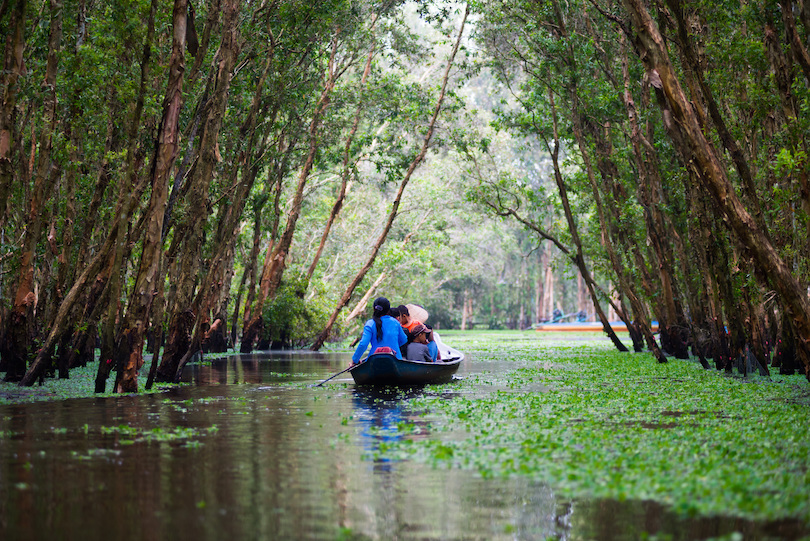
The Mekong Delta, nicknamed the ‘Rice Bowl of Vietnam,’ is a lush network of waterways in Vietnam known for its excellent nutrient-rich soils and diverse ecosystems – the banks are a veritable patchwork of fruit, vegetables, rice plantations and cattle farms that provide sustenance for more than a third of the country.
This impressive stretch of river frontage is the most biodiverse in the world if you don’t count the Amazon. Taking up much of the south of Vietnam, the Mekong Delta is an extraordinary place filled with lily pad waterways, rice paddies, mangroves, and enchanting wildlife.
With plenty of bus connections and motorbikes, tourists can explore the Mekong Delta and its towns like Tra Vinh , which is considered one of the prettiest villages of the delta. A boat trip down the tranquil tributaries and mangroves of the Mekong is an unforgettable experience.
Paddled by a local in a wooden canoe, you’ll be able to witness everyday life on the river, passing farmlands, fruit orchards, monkey bridges, water buffalo, and floating markets . The best time to visit the Mekong is during the dry season between December and May when there’s less chance of flooding.
6. Nha Trang
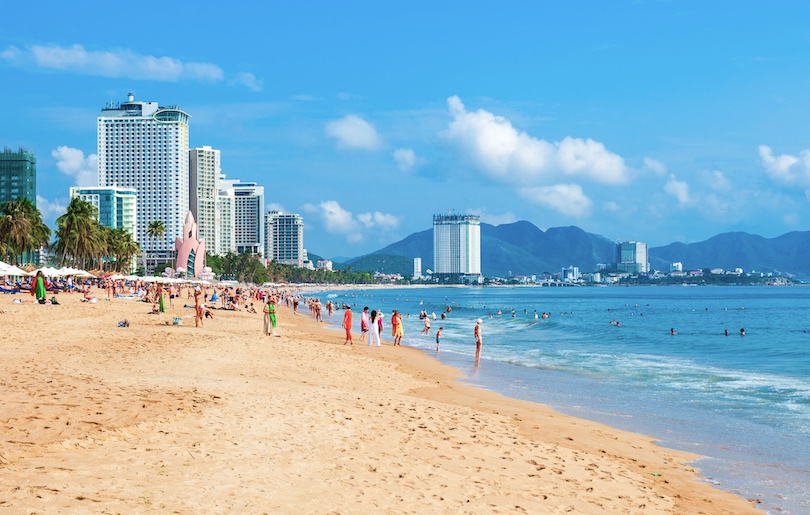
If it’s beaching you’re after, you’ve come to the right place. Nha Trang is the most famous seaside resort in Vietnam, with a laidback atmosphere and exceptional scuba diving. While it’s certainly not on the same scale as many of Asia’s other beautiful beaches , Nha Trang offers warm water and some picturesque offshore islets.
The promenade that encircles the beachfront is always a hive of activity, filled with parks and sculptures that make a stroll here interesting. As with most beach resorts, most of the activity gets going when the sun goes down, and Nha Trang is no different. You’ll find a host of vibey bars and restaurants near the beachfront.
There’s much more to Nha Trang than sunbathing and strolls, though. Go for a soak in the Thap Ba Mud Bath or take a ride on the longest cross-sea cable car in the world. The sacred Po Nagar Cham towers, dating back to the 7th to 12th centuries, offer a taste of the city’s history – they’re an active religious site for Cham, Chinese, and Buddhists even today.
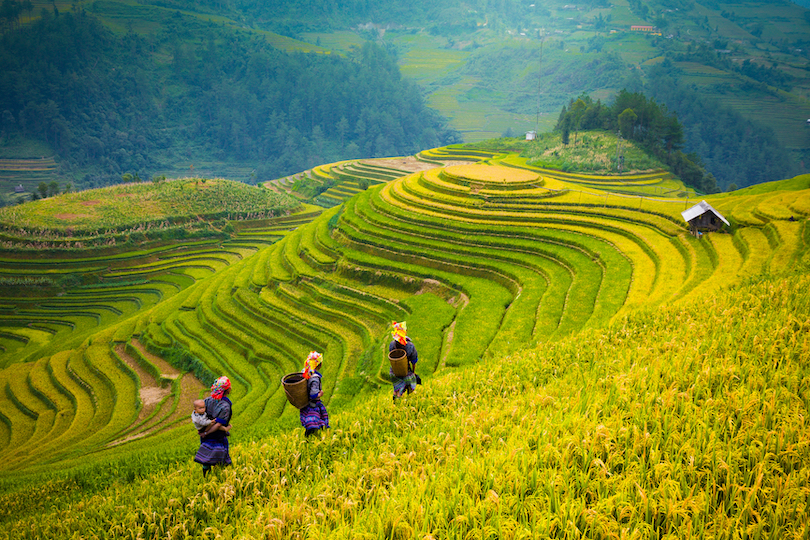
Tracing the border with China, Sapa is a captivating remote town in the Hoang Lien Son mountains of northern Vietnam. Its elevation 1,500 meters above sea level is nothing to scoff at when you’re trekking the terraced hills and slopes around this high-altitude mountain town. While there’s plenty of natural beauty to tempt you to this far-reached corner of the country, much of Sapa’s appeal lies in its raw and authentic culture.
Days are spent trekking through rice paddies , rural villages untouched by tourism, and the clouds of Fansipan – Vietnam’s highest peak.
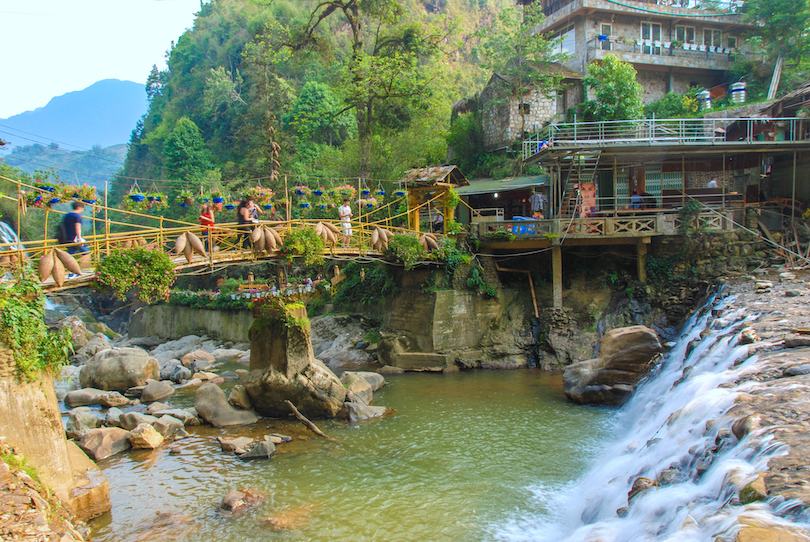
Scenery aside, the highlight is hands down the opportunity to chat with these fascinating people along the way – local kids will tag along and try to sell you some of their handmade jewelry or simply try to improve their English by speaking to you.
In the town of Sapa itself, there are attractive French colonial sites worth visiting such as the Gothic church, the town square and city hall. Sapa is a major market town where the various ethnic tribes in the area often gather to sell their handicrafts, which make excellent souvenirs. At the Sapa Culture Museum, visitors can learn all about the history and cultures of these ethnic groups.
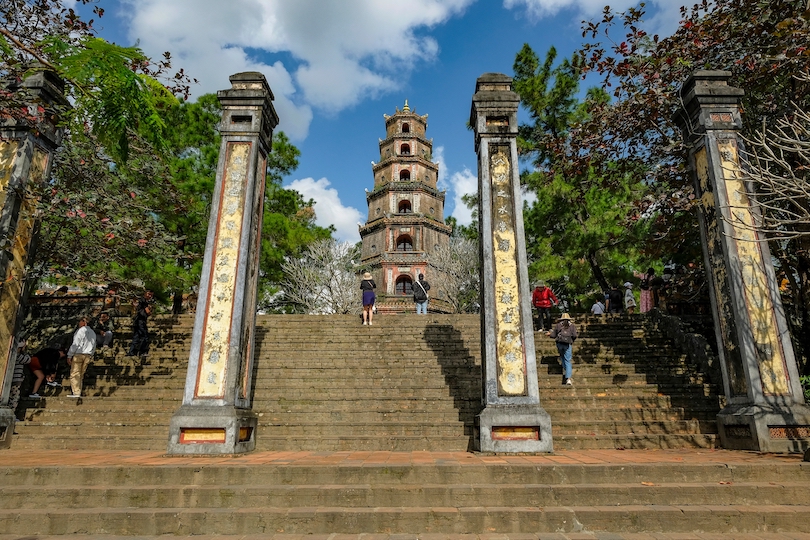
Hue – formerly known as the Panduranga of Cham Kingdom – was once the imperial capital of Vietnam. Located in the central region, Hue had a huge role to play in the Vietnam War. Captured by the Viet Cong for a total of 24 days, thousands of people were killed here if they were thought to be sympathizers of the south.
Today, the city is split in two by the Perfume River. The old city with its ancient ruined citadel lies to the north and the modern-day city to the south. The Demilitarized Zone, which marks the official former border, is one of the most popular day trips from Hue while the Thien Mu Pagoda is the city’s official symbol.
Of the city’s monuments , the Citadel is the most famous. Once the seat of the Nguyen emperors, the Citadel is a sprawling complex of grand palaces, ornate temples, walls and gates. Prime attractions within the Citadel are the Forbidden Purple City, Thai Hoa Palace, and the Ngo Mon Gate. Another important landmark on the river is the city’s official symbol, the Thien Mu Pagoda.
A stroll along the promenade is also recommended, through the statue-abundant parks and onwards by scooter or boat cruise to the Tombs of the Emperors on the outskirts of the city. Dating back to the 19th and 20th centuries, the Tomb of Tu Doc, with its striking Buddhist architecture is the cherry on top.
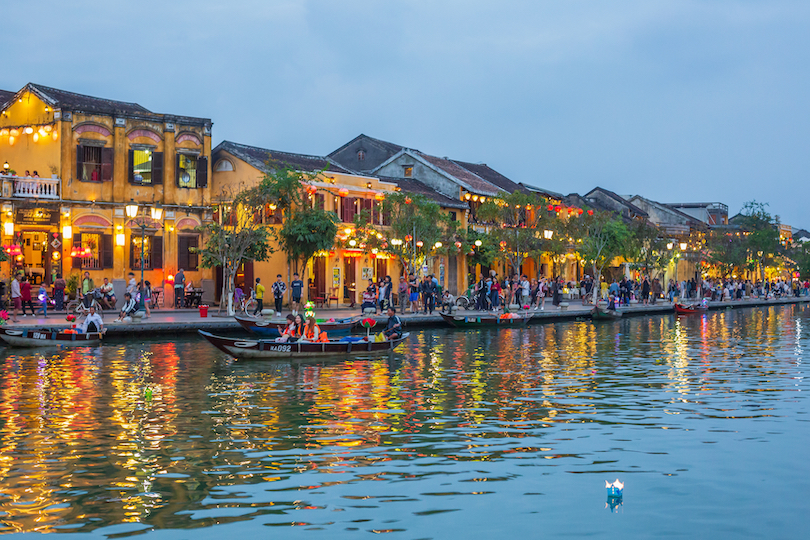
Laidback and charismatic with a charm all of its own, Hoi An is the highlight of any Vietnam itinerary. Located south of Da Nang within cycling distance of some excellent warm-water beaches along the central coast, this atmospheric old town is a feast of color, where bright and cheerful lanterns adorn each and every building.
The narrow, winding lanes of the old town are lined with beautiful historic buildings, Chinese temples and wooden-fronted shops with excellent opportunities for retail therapy. The bustling night market and lantern-lit streets are also great places for shopping and people-watching.
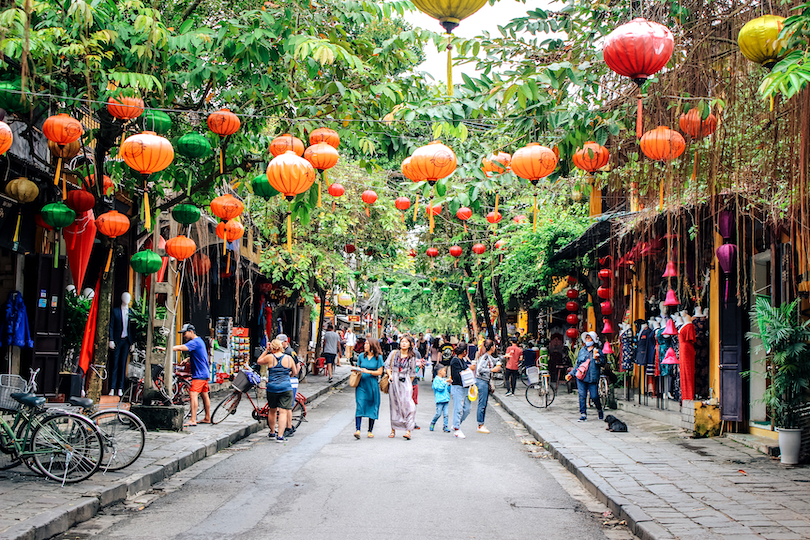
At the same time, you can also take a boat ride along the Thu Bon River or join a cooking class to learn the secrets of Vietnamese cuisine. Wrangle a tempting spa deal, and get a dress or tailored suit handmade for you at one of the town’s many illustrious tailors.
Don’t leave without a visit to the gorgeous Japanese Covered Bridge and the glaze-roofed Chinese merchant houses that date back hundreds of years and house a quarter of the town’s population. There’s plenty to fill your afternoons in Hoi An.

Hanoi, the capital of Vietnam, is truly chaotic, but that’s all part of its charm. An interesting mix of French and Sino-Vietnamese influences, it’s one of the most rapidly growing cities in Southeast Asia.
Those visiting this energetic capital should be prepared. It’s a hive of activity at the best of times, utter chaos at the worst – a city where crossing the road could be taking your life into your own hands with cars, motorbikes, and tuk-tuks vying for right of way in a city without road rules.
One of the best places to experience the madness of Hanoi is at Legend’s Corner . The well-located Legend Beer restaurant is the ideal spot to sit with a drink and watch the rush hour insanity just before sunset. You’ll see pedestrians, dogs, cars, tuk-tuks, and scooters all entwined in traffic, yet somehow there are very few accidents.
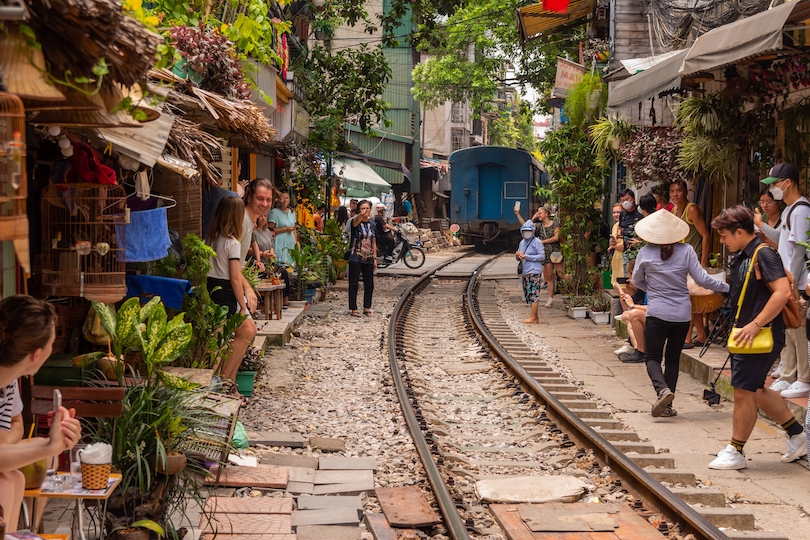
Hanoi’s historic Old Quarter is a maze of narrow streets filled with charming colonial architecture, street vendors, and bustling markets. The best way to explore it is on foot or by cyclo (cycle rickshaw). This will enable you to soak up its atmosphere and discover hidden gems like the ancient Temple of Literature or the vibrant Dong Xuan Market.
See also: Where to Stay in Hanoi
For a change of pace, go for a stroll around the freshwater Hoàn Kiếm Lake in the Old Quarter or soak up more Vietnamese history with a visit to the Thăng Long Imperial Citadel. The Ho Chi Minh Mausoleum , the final resting place of the Revolutionary leader and Vietnamese President, is a must-see.
1. Ha Long Bay
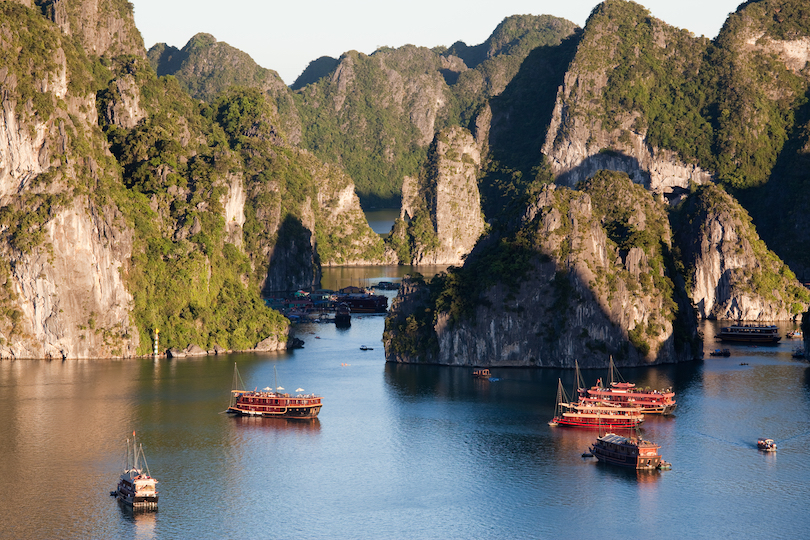
Located about 130 km (80 miles) east of Hanoi in northern Vietnam, Halong Bay is celebrated for its gorgeous emerald-hue waters, thousands of spectacular limestone karsts, astonishing waterside caves, and beautiful tree-topped islands.
It’s a popular location for adventure – scuba diving, kayaking, hiking, and rock climbing can all be enjoyed in and around Cat Ba National Park . For those who wish to simply relax and enjoy the views, there are numerous Halong Bay cruises to choose from, from basic to top-level luxury.
The thousands of islands scattered about the bay are a real mixture, ranging from isolated landmasses home to free-roaming monkeys and antelope to bigger inhabited islands with some fantastic beaches . Boat cruises are the best way to experience the natural wonder of Ha Long Bay.
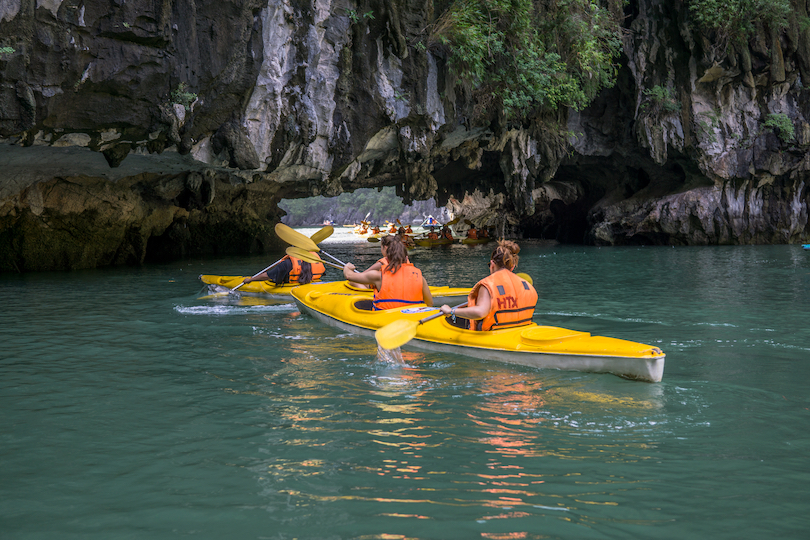
With hundreds of boats ranging from traditional Chinese junks to luxury cruisers, boat tours can vary from day trips to multiple-night journeys . These tours often provide meals, nightlife activities and excursion stops where islands, caves and lagoons can be explored. Most boat cruises are arranged either from Hanoi or from ports such as Haiphong, Halong City and Cai Rong.
As with most holidays on the water, Halong Bay is easily affected by the weather. Plan your trip between March and June to get the most out of your visit. June to September is the off-season, so you can usually get some great deals – just be sure to keep an eye on the weather forecast as monsoons can really put a dampener on your trip.
Map of Places to Visit in Vietnam
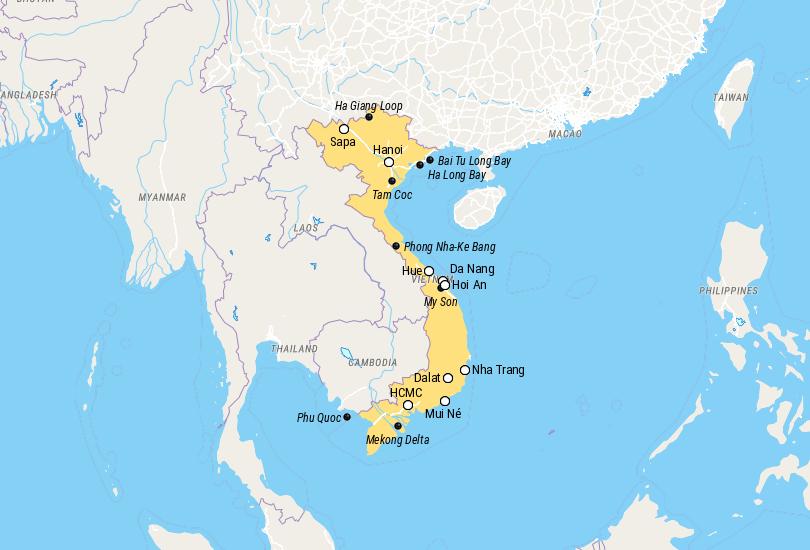
Share this post:
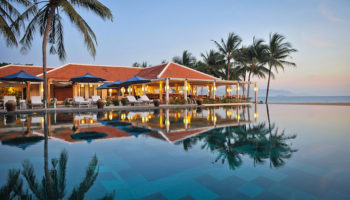
10 Best Vietnam Luxury Resorts
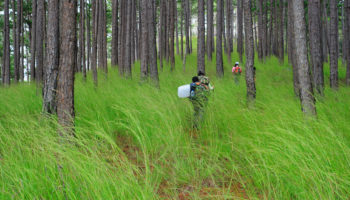
12 Most Beautiful National Parks in Vietnam
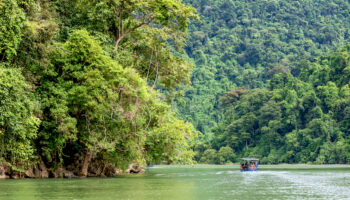
10 Most Underrated Destinations in Vietnam
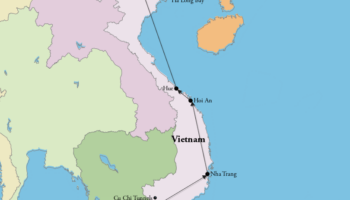
How to Spend 2 Weeks in Vietnam: DIY Itinerary
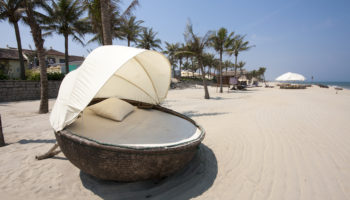
10 Best Beaches in Vietnam
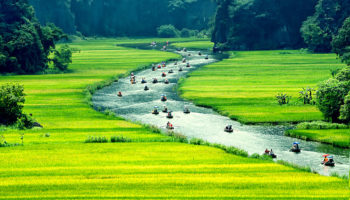
25 Top Tourist Attractions in Vietnam
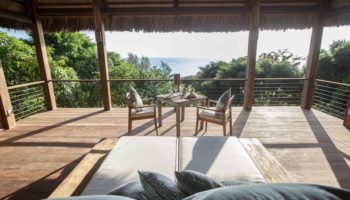
11 Most Amazing Hotels in Vietnam
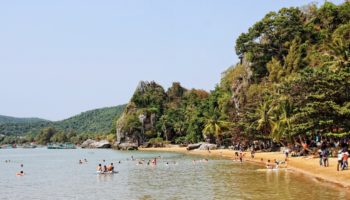
10 Most Beautiful Islands in Vietnam
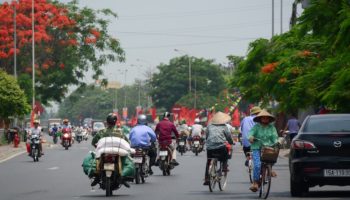
17 Best Cities to Visit in Vietnam
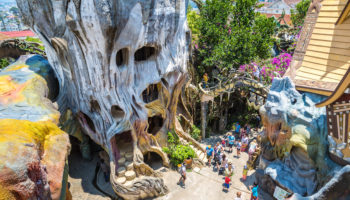
12 Best Things to do in Dalat, Vietnam
Reader interactions.
September 15, 2019 at 1:19 am
I hereby compose a key-word list of outstanding places in Vietnam. Hope it’s helpful for you guys searching.
1. Islands: Côn Đảo ; Phú Quốc ; Lý Sơn, Cam Ranh, Bình Ba, Bình Hưng, Điệp Sơn ,Đảo Yến Hòn Nội, ,Cù lao Chàm , Đảo Nam Du, Hòn ông đảo cá voi, Cát bà.
2. Best beaches on islands Bãi Nhát ( Côn Đảo ), Bãi Suối Nóng ( Côn Đảo ), Hòn Cao ( Côn Đảo ), Bãi Sao ( Phú Quốc ), Bãi Khem ( Phú Quốc ), Bãi ông Lăng ( Phu Quoc ) , Nam Du ( Phu Quoc ), Dao Be ( Ly son ) , Bai Kinh ( Binh Hung), Bai Nom ( Binh Ba ),
3. Coastal Cities : Ha Long, Da Nang, Nha Trang, Mui Ne, Quy Nhon, Vung Tau.
4. Best beaches on coastal cities: Doc Let, Dai Lanh, My Khe, Nha Trang, Ky Co, Bãi Binh Tien, Bãi Cà ná, Bãi bắc beach da nang, quy nhon beach.
5. Best Bays Ha Long Bay, Lang Co bay, Nha Trang bay, Ninh Van bay, Van Phong bay, Cam Ranh bay.
6. Highland cities/town offer great mountain views, trekking activities : Sapa, Da Lat, Ha Giang, Cao bang.
7. Ancient cities/towns : Hoi An, Dong Van, Hue
8. Caves: Phong Nha, Thien duong, Son Doong, Hang En, Hang Sung Sot, Hang Va, He thong hang dong Tu Lan, Tam Coc bich dong
9. Rivers Mekong delta, Sông Ngô Đồng, Tràng An, Sông đáy chùa hương, Sông Son, Sông Nho Quế, Sông Chày.
10. Waterfall Thác Bản Giốc, Thác Voi, Thác Pongour
11. Lakes Hồ Ba bể, Hồ Xuân Hương, Hồ Tuyền Lâm, Hồ Tơ Nưng, Hồ Lắk, Hồ Hoàn Kiếm, Hồ Thác Bà, Phá Tam Giang.
12. Lagoons Pha Tam Giang, Đầm Vân Long.
13. National Parks Phong Nha ke bang, Nam Cát Tiên, Bạch Mã, Cúc Phương, Ba Vì, Ba Bể, Tràm Chim Tam Nông, núi chúa.
14. Terraces rice field Mù Căng Chải, Hoàng Su Phì, Tú Lệ , Sapa, Y Tý, Bát Xát, Pù Luông.
Enjoy your traveling trip!
May 1, 2019 at 2:46 am
I like Vietnam. I really do. I love their culture and traditions. Just recently I went on a trip to Vietnam and I absolutely loved it. The people there were so nice and lovely. The wildlife, vegetation and sacred places were amazing too. But I have to say, the most beautiful place that I went to in Vietnam is Ha Long Bay. The scene was incredibly stunning! I also stayed in Sapa. It has astonishing views. Especially when you look at it from a distance. It has fog surrounding the buildings, has tall mountains in the background and has brightly coloured buildings. It’s breathtakingly beautiful!
March 3, 2019 at 1:49 am
I am a Vietnamese and according to my experience, there are two places you should visit when you are in Vietnam: Cat Ba Island in the Northeast Vietnam and Phu Quoc Island in the Southeast Vietnam.
March 29, 2018 at 9:26 pm
The market in Can Cau is fabulous.
November 21, 2017 at 10:29 pm
I think these places are amazing to visit but I have a question, how is Vietnam in general? Is it a safe country to visit ??
November 8, 2017 at 8:19 am
I recommend Pu Luong nature reserve, not very far from Hanoi.
September 19, 2017 at 4:52 pm
I really liked Da Nang.
November 23, 2016 at 4:13 am
Great list. I have just spent two months in Vietnam and did most of the places except My Son and Sapa. Will come back for that. Love this country!
July 21, 2015 at 2:04 pm
There are lots of day trip activities from Hoi An– snorkeling or diving at the Cham Islands, early morning cycling trips to the countryside, visiting the My Son archeological ruins. Hoi An also has terrific food, and is a great place to wander around and explore.
June 2, 2015 at 6:46 am
There are at-least 30 incredible places to visit in Vietnam, your list is correct those are about the top places but there are alot more amazing places in Vietnam and no one should stop at just 10
November 7, 2014 at 4:11 am
Great places. You can also put Ninh Binh and Ha Giang.
Leave a Reply Cancel reply
Your email address will not be published. Required fields are marked *
This site uses Akismet to reduce spam. Learn how your comment data is processed .
- Customized Tour
Top Tourist Attractions in Vietnam

Before planning a trip to Vietnam , you must do a lot of research to find out the top tourist attractions to visit. Among the top tourist attractions in Vietnam, iconic sites like Ha Long Bay, the Imperial City of Hue, and the historic Old Quarter of Hanoi are must-sees. Thanks to such a huge stretch from the North to the South, over 3200 kilometers, crossing various topographies, Vietnam holds in itself a collection of mountains, deltas, rivers, caves, lagoons, ocean, canals, hills. Vietnam Travel lists top destinations below which shows the best features of the country.
Table of Contents
1. Ha Long Bay
4. ninh binh, 5. phong nha – ke bang national park, quang binh, 6. hue citadel, 9. ho chi minh city (saigon), 10. phu quoc, places to visit in vietnam off the tourist trail.
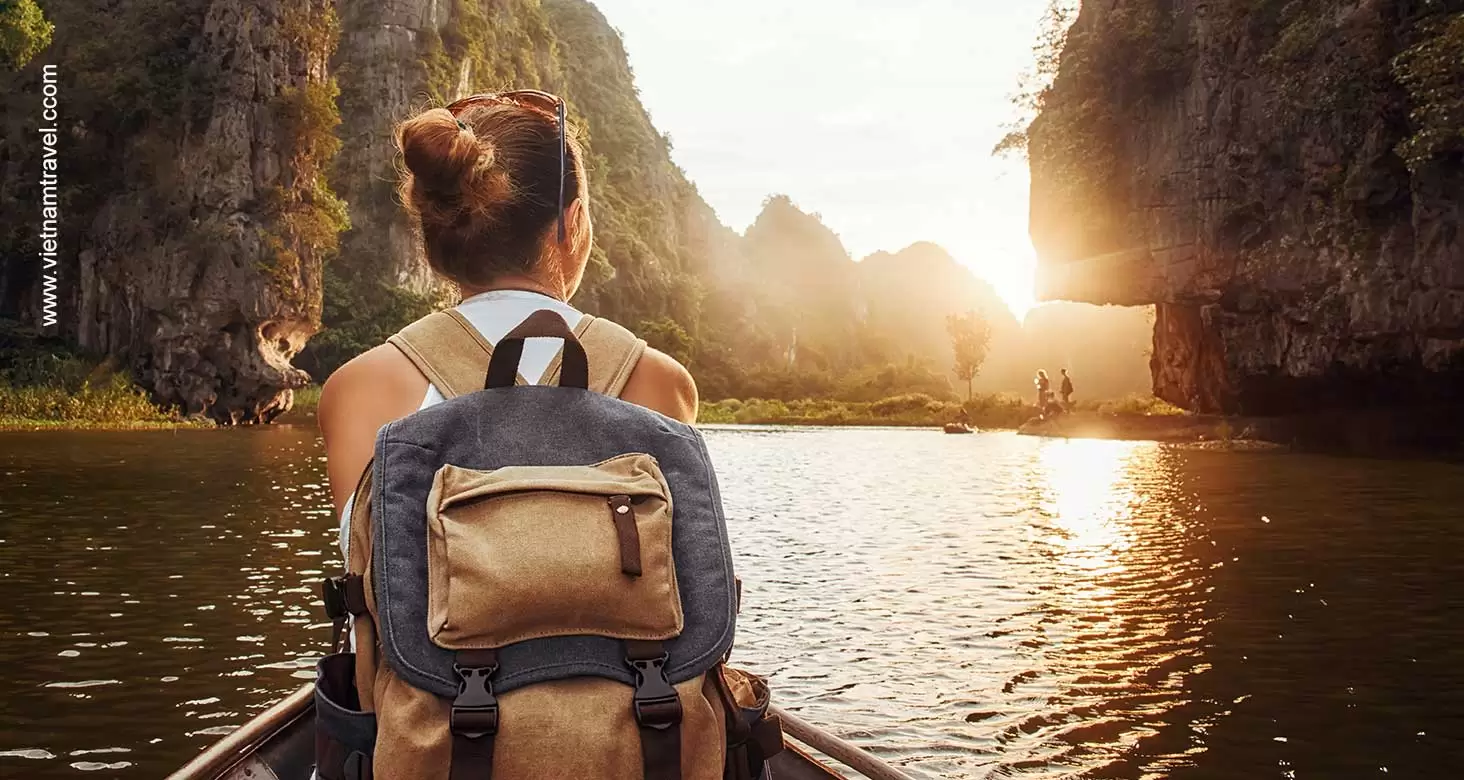
Leading the chart of the top tourist attractions in Vietnam should not be something else but the sensational Ha Long Bay. The UNESCO World Heritage Site added another sight to see in their list presenting the world’s most spellbinding karst seascape, Ha Long Bay even twice. One was in 1991 and the other one was in 1998. Situated along the Gulf of Tonkin, there lies thousands of limestone islands scraped away by nature into breath-taking rock formations. It is highly recommended to spend an overnight tour to fully appreciate the iconic views this site has to offer.
The best times to visit Halong Bay are during the spring (March to May) and autumn (September to November) when the weather is mild and dry, providing ideal conditions for exploring the bay’s iconic limestone islands and enjoying outdoor activities.
If you’re interested in immersing yourself in the local culture, consider timing your visit to coincide with one of the region’s vibrant festivals or events. The Halong Carnival, held annually in late April or early May, is a lively celebration featuring street parades, traditional music and dance performances, and delicious local cuisine.
To fully appreciate the wonders of Halong Bay, an ideal duration of stay is 2-3 days. This allows ample time to embark on a cruise through the bay, exploring its hidden caves, secluded beaches, and floating villages. Additionally, you’ll have the opportunity to participate in various activities such as kayaking, hiking, and visiting nearby attractions like Cat Ba Islands .
Speaking of top activities, a Halong Bay cruise is an absolute must-do. These multi-day cruises offer the chance to witness the bay’s incredible scenery up close while indulging in luxurious amenities. Other popular activities include exploring the mystical caves like Sung Sot Cave, Thien Cung Cave , hiking to scenic viewpoints like Ti Top Island, and participating in water sports like kayaking or swimming in the bay’s emerald waters. Additionally, don’t miss out on discovering the fascinating things to do in Halong City , such as visiting local markets, enjoying fresh seafood, and experiencing the vibrant nightlife.
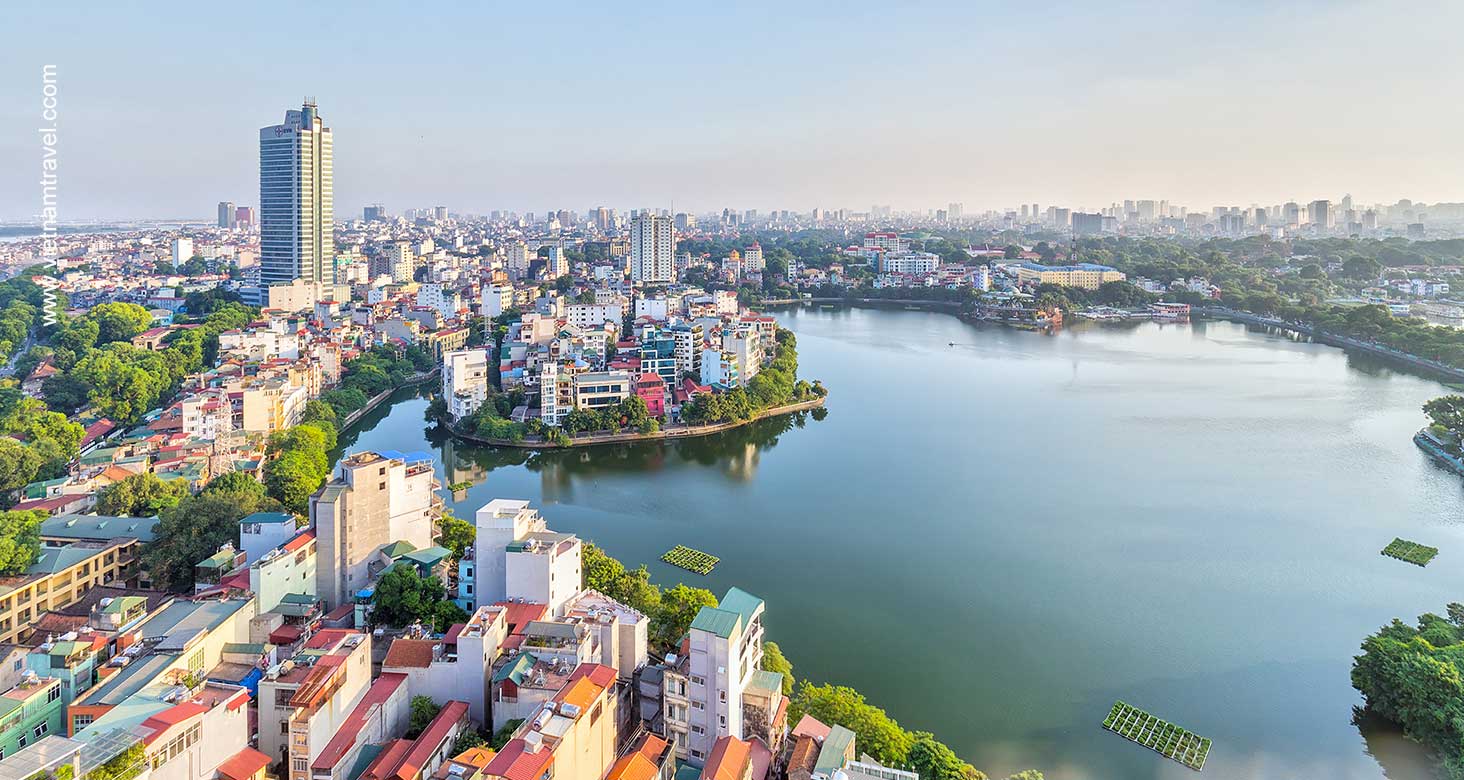
Hanoi, the capital of Vietnam , attracts millions of visitors each year. Hanoi has a long history of 1000 years of culture and civilization that attracts visitors of its old age. Traveling to Hanoi , you cannot miss Long Bien Bridge (over 100 years old), Hoa Lo Prison (Hilton House), Temple of Literature , Bat Trang pottery village , Hoan Kiem Lake , Ngoc Son Temple and many different kind of museums such at Vietnam museum of Ethnology , Vietnam Fine Art Museum , etc. Besides, Hanoi Old Quarter is a favorite place of many travelers.
The best times to visit Hanoi are during the spring (March to May) and autumn (September to November) when the weather is pleasant, with warm days and cool evenings. If you’re seeking to immerse yourself in the city’s vibrant cultural tapestry, consider timing your visit to coincide with one of Hanoi’s iconic festivals, such as the Lunar New Year celebrations or the Mid-Autumn Festival, both of which showcase traditional music, dance, and culinary delights.
To fully experience the city’s charm, an ideal duration of stay in Hanoi is 3-4 days. This allows ample time to explore its historic Old Quarter, visit iconic landmarks like the Temple of Literature and Ho Chi Minh Mausoleum, and indulge in the city’s renowned street food scene. Top activities in Hanoi include taking a cyclo tour through the bustling streets, attending a traditional water puppet show, exploring the Imperial Citadel of Thang Long, and embarking on a day trip to the picturesque Ninh Binh province, renowned for its stunning karst landscapes. Don’t miss out on discovering the diverse range of things to do in Hanoi , from exploring ancient temples to sampling local delicacies in bustling markets.
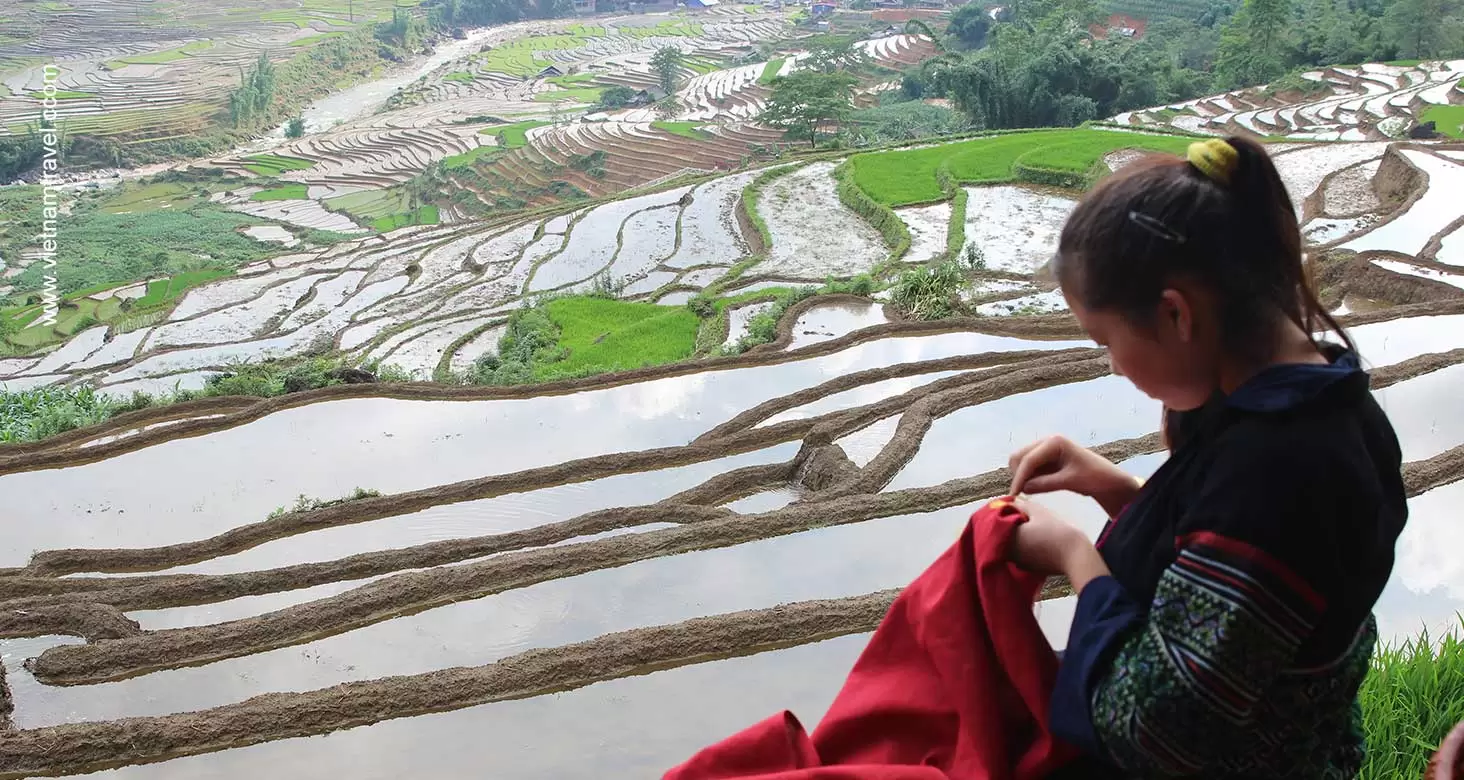
Sapa is located in Lao Cai Province , about 350 km northwest of Hanoi, close to the Chinese border. Traveling to Sapa to discover the north mountainous area of Vietnam with the Hoang Lien Son range of mountains, which includes Fan Si Pan—the country’s highest peak. In Sapa, you can both enjoy the beauty of nature with stunning mountains, colorful paddy fields and experience our various culture of H’Mong ethnic minority. Here, travelers can spend their time hiking in the villages of Cat Cat , Y Linh Ho , Lao Chai and Ta Van Villages . If, you love to discover the remote village where less tourist travel, you can go to Can Cau Village to visit local market and Love market as well. After all, your memories to Sapa would be filled with the exotic cuisine, the colorful costumes of the ethnic minorities and the stunning of nature.
The best times to visit Sapa are during the spring (March to May) and autumn (September to November) when the weather is mild and dry, providing ideal conditions for trekking and enjoying the town’s picturesque landscapes.
If you’re interested in immersing yourself in the local culture, consider timing your visit to coincide with one of Sapa’s vibrant festivals or events, such as the Bac Ha Sunday Market or the Gau Tao Festival, where you can witness traditional dress, music, and dance performances by the region’s ethnic minority groups.
To fully appreciate the wonders of Sapa, an ideal duration of stay is 3-4 days. This allows ample time to embark on guided treks through the verdant rice terraces and visit remote hill tribe villages, as well as explore the town’s charming French colonial architecture and bustling markets.
Top activities and things to do in Sapa include trekking through the breathtaking Muong Hoa Valley, visiting the Love Waterfall and Bamboo Forest, exploring the Bac Ha Sunday Market for traditional handicrafts and textiles, and indulging in local delicacies like Thang Co (a unique sour soup). Additionally, adventurous travelers can partake in thrilling experiences like a Mt. Fansipan climb or a motorbike tour through the winding mountain roads.
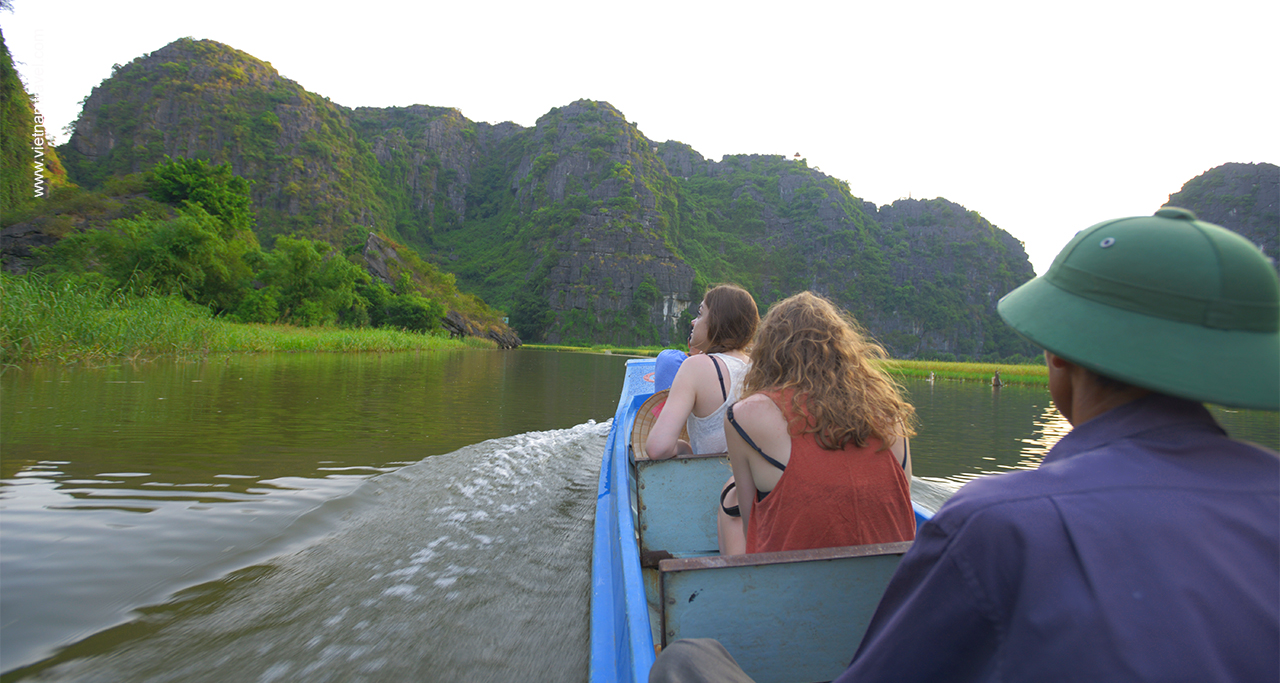
If Ha Long Bay is the rocky limestone destination in the northern far seas, then Ninh Binh is would be the equivalent on the mainland. Located around 95km south of Hanoi, Ninh Binh and its’ neighboring area Tam Coc are filled with similar sights from the emerald green waters of Ha Long Bay . Being the perfect place to start an adventure around Vietnam and Cambodia, Nan Binh is a favored spot for tourists to post on social media, especially for its natural and untouched beauty.
In addition to the captivating natural features that Ninh Binh has to offer, the city is known to be the ancient capital of feudal Vietnam during the 11th century under the Dinh and the Early Le Dynasties. A two-day trip all around Ninh Binh would give you an ideal insight into how the ancient Vietnamese once ruled their country against the major outside force from China.
The best times to visit Ninh Binh are during the spring (March to May) and autumn (September to November) when the weather is pleasant and dry, providing ideal conditions for exploring the region’s iconic limestone landscapes and enjoying outdoor activities.
To truly appreciate the wonders of Ninh Binh, an ideal duration of stay is 2-3 days. This allows ample time to explore the breathtaking Trang An Landscape Complex, a UNESCO World Heritage Site renowned for its stunning karst formations, caves, and tranquil waterways, as well as visit nearby attractions like the ancient capital of Hoa Lu and the stunning Bai Dinh Pagoda complex.
Top activities and things to do in Ninh Binh include taking a mesmerizing boat tour through the limestone karst formations of Trang An, exploring the ancient temples and citadels of Hoa Lu, embarking on a cycling adventure through the picturesque countryside and rural villages, and indulging in the local cuisine, which features unique dishes like goat meat and specialties from the nearby Cuc Phuong National Park.
Read more: Ninh Binh Travel guide
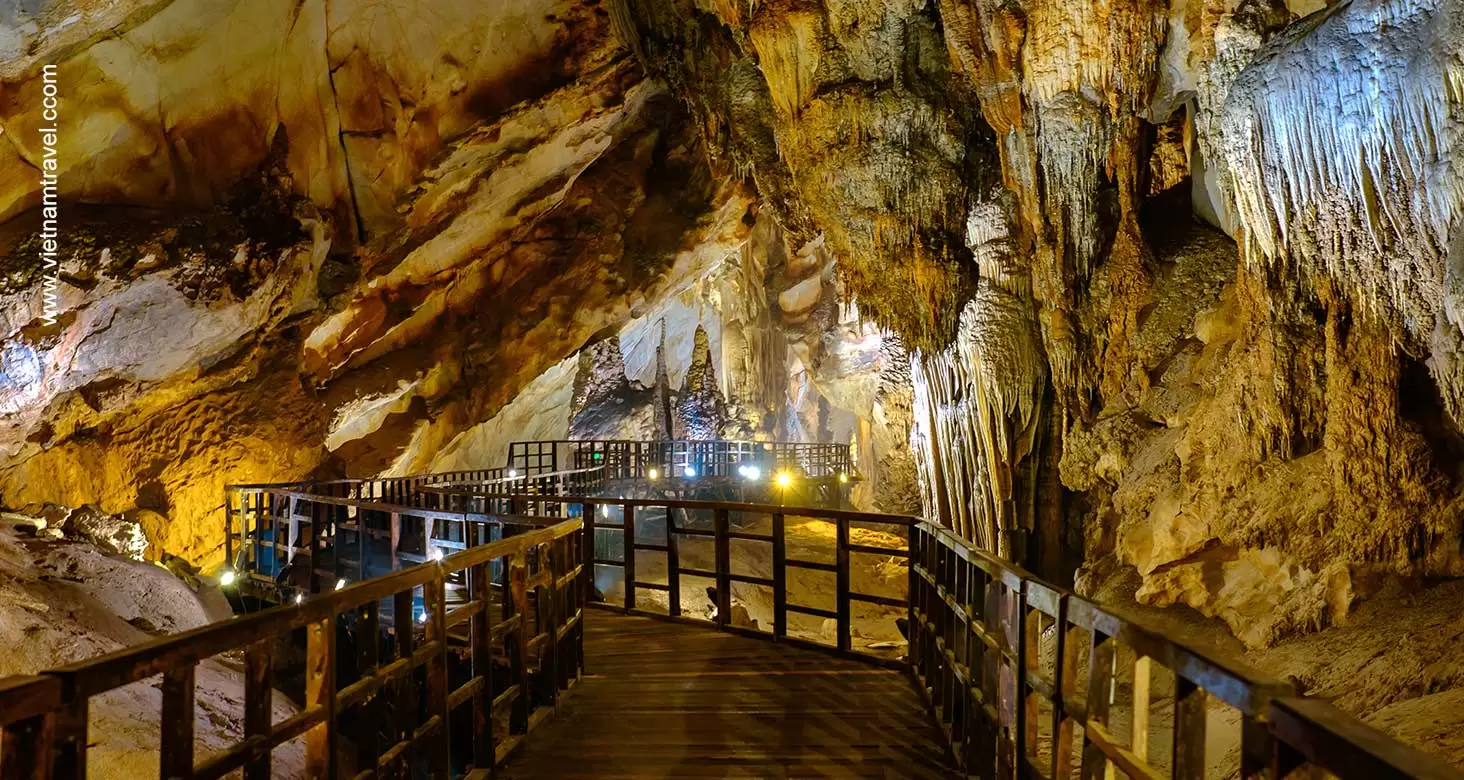
Located in Quang Binh province , central Vietnam, this mysterious land is endowed with breathtaking landscape of limestone mountain ranges, wild forests and stunning rivers. This place which is recognized by UNESCO World Heritage Site in 2003, famous for the largest cave in the world with whole ecosystems and forests within, called Son Doong cave . Son Dong cave is 5km long, 200m high and 150m wide. But it is not Son Dong, with more than 300 caves, many waterways, mountains and forests, Phong Nha – Ke Bang national park is now a famous destination for tourists from all over the world to trekking, hiking, cycling and kayaking.
Adventure awaits year-round in Phong Nha – Ke Bang National Park, but the dry season (March-August) offers ideal conditions for exploring. Hike through lush rainforests, delve into the world’s largest caves, or kayak on crystal-clear rivers. Aim for a stay of 2-3 days to experience the park’s highlights, like Paradise Cave or Phong Nha Cave. Don’t miss a boat trip down the Son River for a truly unforgettable experience!
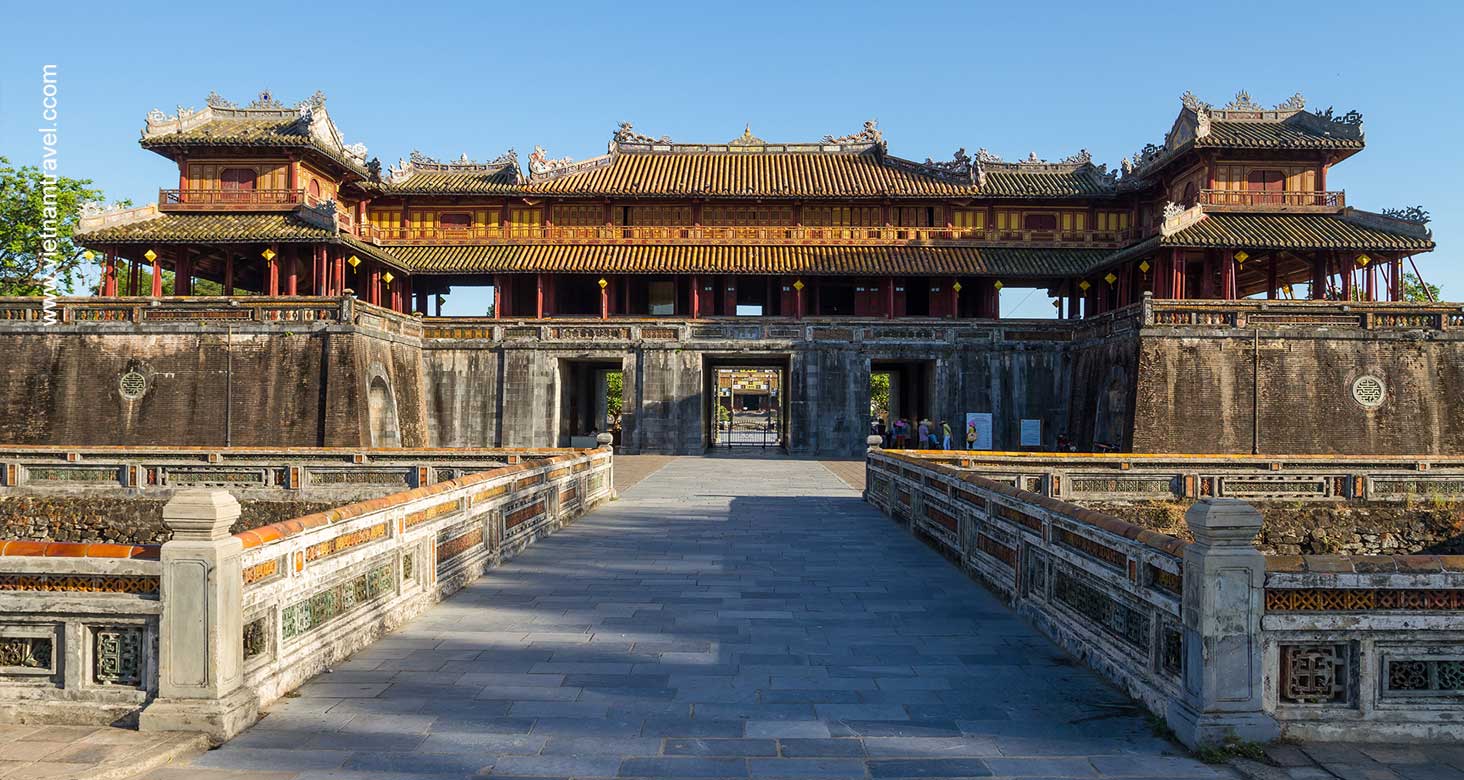
Knowing as the place of the last reign – Nguyen dynasty, Hue is considered one of Vietnam’s most historic towns and the former imperial capital of the country. The emperor’s residence, palaces, and temples are some of the historic sites left standing inside walls of the Imperial Enclosure that spans for around 2.5km along the Perfume River . Other landmarks are the citadel’s main entrance, the Ngo Mon Gate, the Thai Hoa Palace with its intricate interiors, Dien Tho Residence which serves as the Queen Mothers’ chambers and lastly the Hall of Mandarins housing its’ well-preserved ceiling murals.
Hue, Vietnam’s former imperial capital, is best explored during the dry season (February-August) when skies are clear and temperatures comfortable. History buffs will be enthralled by the city’s vibrant past, evident in its magnificent Hue Imperial Citadel and royal tombs. Hue also boasts a rich festival scene, with the Hue Festival offering a spectacular display of traditional performances and colorful parades. To fully appreciate Hue’s imperial charm and cultural treasures, a 2-3 day stay is ideal. Don’t miss a boat trip on the Perfume River, exploring bustling local markets, and indulging in Hue’s renowned royal cuisine.
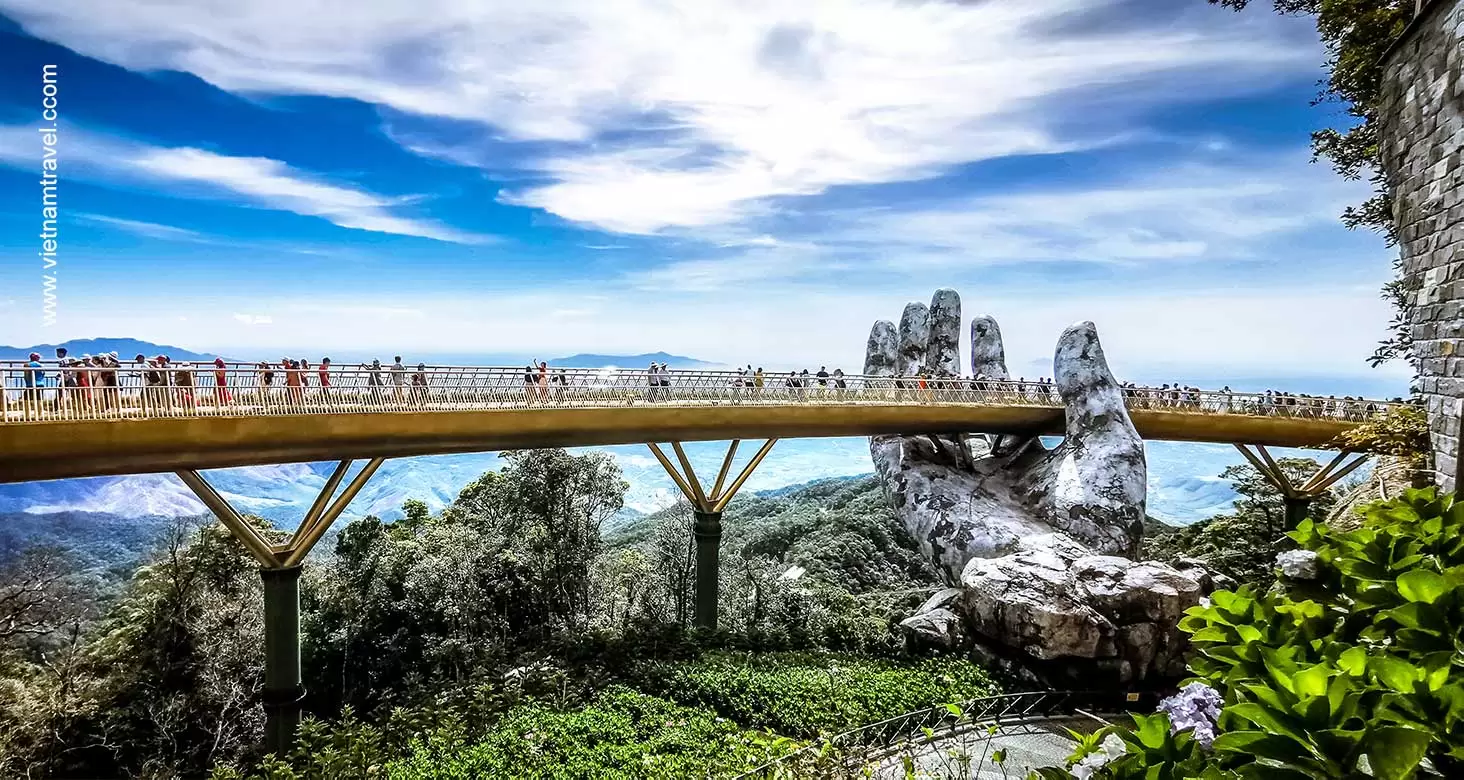
Da Nang will surprise you by its modern, cleanness and nature. Da Nang has so many things to offer from Hai Van Pass, Marble Mountain, Ba Na hills to the Golden bridge . The fresh and beautiful white sand beach also Nang are also one of the reasons to hold tourist stay longer at this city. The amazing traditional food here is also one thing visitors could not resist.
Da Nang’s charm unfolds throughout the year, but the best time to visit depends on your preferences. For sunshine and warm seas ideal for swimming and lounging on the beach, April to August offers the most pleasant weather. This peak season coincides with the Da Nang International Fireworks Festival, a dazzling spectacle that usually takes place in April or May (check specific dates as they follow the lunar calendar).
If you prefer smaller crowds and don’t mind occasional rain showers, consider visiting during the shoulder seasons (September to November and March to May). You might even snag some travel bargains during this time. Three to five days is a good amount of time to explore Da Nang’s beaches, historical sites, and surrounding attractions. If you’re planning day trips to Hoi An or My Son Sanctuary, factor those into your itinerary.
Top activities in Da Nang include relaxing on pristine beaches like My Khe Beach, exploring the Marble Mountains with their stunning caves and pagodas, and getting a dose of history at the Museum of Cham Sculpture. Adventure seekers can try surfing or scuba diving, while foodies will delight in Da Nang’s fresh seafood and flavorful central Vietnamese cuisine .
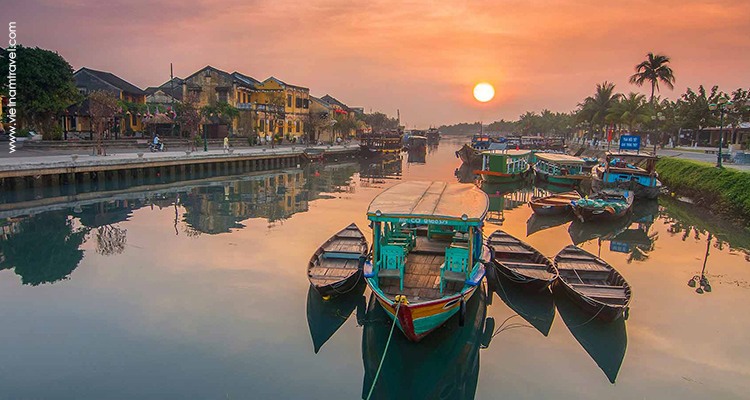
Hoi An is the place where not only attracting newcomers but also encouraging many tourists to come back again. It is famous for being an ancient town where the rustic yellow-walled tubed buildings line up. The town was built and developed by the Japanese, Chinese and Vietnamese in which the Chinese architecture is the main theme throughout the whole site. The most sought-after destinations are the Thanh Ha Pottery Village, Tra Que Herb Village, and Kim Bong Carpentry Village. Besides, there are plenty of restaurants with lots of variety at cheap price, the night markets are great and the people are lovely. It truly is a paradise for visitors to go and explore.
The dry season (February to August) offers sunshine, warm temperatures, and minimal rain, making it ideal for sightseeing and outdoor activities. However, this coincides with peak tourist season. For pleasant weather with fewer crowds, consider the shoulder seasons (March to May or September to November). March to April boasts comfortable temperatures and coincides with the Full Moon Lantern Festival, transforming Hoi An into a magical spectacle with glowing lanterns illuminating the Thu Bon River.
Throughout the year, Hoi An comes alive with vibrant festivals. The Full Moon Lantern Festival, held on the 14th day of each lunar month, is a must-see, while the larger Festival of Lights in February celebrates Vietnamese traditions with lantern displays and performances.
2-3 days is a good amount of time to explore Hoi An’s captivating ancient town, with its well-preserved architecture, tailor shops, and Japanese Covered Bridge. Foodies can delve into Hoi An’s culinary scene, while beach lovers can relax on nearby Cua Dai Beach. If you’re planning day trips to My Son Sanctuary or Da Nang, factor those into your itinerary.
Discover the enchanting streets of the ancient town, a UNESCO World Heritage Site. Get custom clothing made by skilled tailors, a Hoi An specialty. Take a boat ride on the Thu Bon River, adorned with colorful lanterns at night. Learn about Hoi An’s history at museums like the Fukian Assembly Hall and the Tan Ky House. Relax on the pristine sands of Cua Dai Beach or try water sports. In the evening, take a boat trip and release floating lanterns, a beautiful local tradition. Don’t forget to explore the vibrant things to do in Hoi An , including sampling delicious local cuisine and participating in traditional lantern-making workshops.
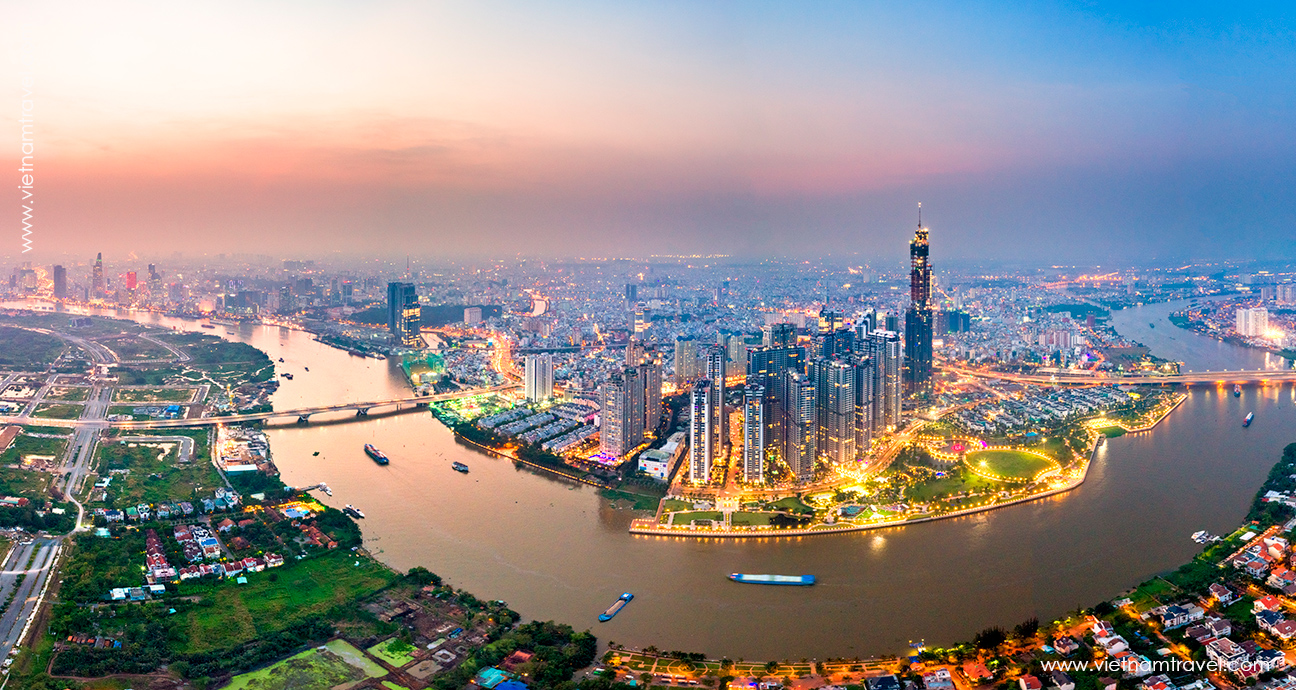
Saigon – Ho Chi Minh City is such a young and modern city born and raised for roughly over 300 years. Traveling here, you will see the attractions influenced by the French-era architecture such as Vietnam’s own Notre Dame Cathedral , the War Remnants Museum , and Ben Thanh Market . The Central Post Office, Reunification Palace are also visited by travelers.
Let’s not stop here, Sai Gon by night attracts you by its vibe and personal charming, please wander around Bui Vien streets, or taste local cuisine such as Huynh Hoa Bread (Banh my Huynh Hoa), Sauce Noodle (Bun mam), Nam Vang vermicelli (Hu tieu Nam Vang), Crab noodle (Banh canh cua), grilled pork noodle (bun thit nuong0, etc. Ho Chi Min h is also as a stop-over for tourists of they want to visit Mekong Delta , Cu Chi Tunnel , Cao Dai temple, Vung Tau and the other southern provinces.
The ideal time to visit Ho Chi Minh City is during the dry season from December to April, when the weather is most pleasant, offering clear skies and comfortable temperatures for exploring the city’s vibrant streets and historical landmarks.
The city’s calendar is dotted with cultural festivals and events, such as the exuberant Tet Festival in January or February, where the city bursts into celebrations of the Lunar New Year Attending this festival is a unique opportunity to immerse yourself in local traditions and witness the city at its most festive.
For travelers wondering about the ideal duration of stay, three to four days are recommended to fully experience the city’s top attractions and hidden gems. This allows ample time to delve into the rich history at the War Remnants Museum, marvel at the architectural wonder of the Notre-Dame Cathedral Basilica of Saigon, and indulge in the culinary delights of street food tours in District 4.
Discover the best things to do in Ho Chi Minh City, from exploring iconic attractions like the Ben Thanh Market and the Reunification Palace to immersing yourself in the vibrant atmosphere of the city’s night markets . Indulge in local delicacies, shop for souvenirs, and soak in the bustling energy of places like Binh Tay Market in Chinatown. Additionally, experience the charm of Nguyen Hue Street at night, lined with dazzling lights and bustling cafes, offering a perfect blend of culture and entertainment.
Incorporating these elements into your itinerary will ensure a memorable journey through the heart of Vietnam’s most dynamic city, where traditional charm meets modern vitality. Whether you’re a history buff, food enthusiast, or simply in search of adventure, Saigon’s warm embrace has something for everyone.
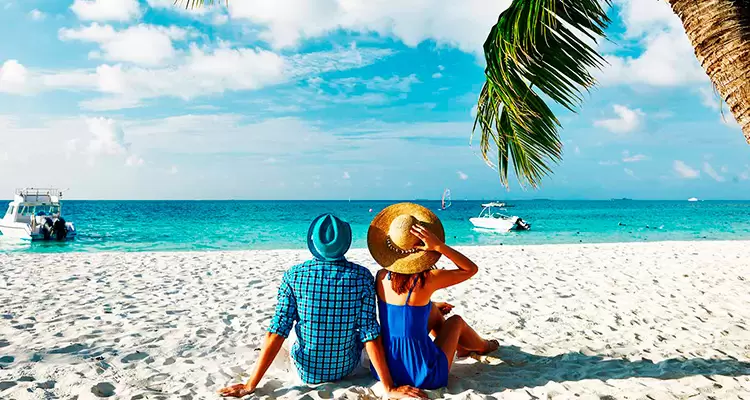
Unlike Bali or Thai Lan, Phu Quoc is an isolated tropical island located down South of Vietnam with 150km of coast in which you can reach there by plane at Phu Quoc International Airport . Phu Quoc is well known with many white sandy beaches and a perfect combination from mountain to forest and sea. With such a balmy weather, Phu Quoc is a good choice for all travelers who love nature and seek for a place to balance sightseeing and beaches. You can spend your time at your luxury resort or walk along the sandy beach to enjoy the fresh air or dipping yourself under the fresh green water of the sea. At the end of the day, Phu Quoc will end up with the colorful sky to complete your day with such a customized romantic dinner next to the beach. Travelling to Phu Quoc will bring you pleasant and relaxed.
The best times to visit Phu Quoc are from October to April, when the weather is dry with little rain, perfect for beach activities and exploration. This period also includes the peak tourist season, so for those seeking a quieter experience, the shoulder seasons of April to June or October provide a more tranquil atmosphere.
The island’s vibrant culture comes to life with festivals and events that are not to be missed. From the traditional Tet Festival celebrating the Lunar New Year to the Viet Traditional Music Festival, these cultural showcases offer a deep dive into the island’s rich heritage.
For an ideal visit, 2 to 5 days in Phu Quoc allow for a comprehensive experience, giving you enough time to explore the central town of Phu Quoc Islands, the serene Phu Quoc beaches likes Khem beach, Sao beach, Long beach, the bustling south, and the untouched eastern part of the island.
Top activities in Phu Quoc include exploring the Phu Quoc National Park, lounging on the pristine Sao Beach, and indulging in the tranquility of Khem Beach. For adventure seekers, snorkeling, scuba diving, and trekking are among the must-do activities. Whether you’re looking to immerse yourself in nature, enjoy the local cuisine, or simply relax on the beach, Phu Quoc caters to all desires, making it a must-visit destination on your Vietnam journey.
While Ha Long Bay and Hoi An hold undeniable charm, Vietnam offers a treasure trove of experiences beyond the usual tourist haunts. For those seeking an authentic and off-the-beaten-path adventure, here are a few hidden gems waiting to be discovered:
- Cao Bang: Venture further north to Cao Bang, a land of untouched beauty. Explore the Ban Gioc Waterfall, the country’s most impressive cascade, or delve into the mystique of the Pac Bo Cave, a historical landmark significant to Ho Chi Minh president.
- Ha Giang Loop : Nicknamed Vietnam’s “final frontier,” Ha Giang is a motorbiker’s paradise. Dramatic mountains pierce the clouds, while winding roads snake through emerald rice terraces cultivated by ethnic minorities. Here, immerse yourself in a simpler way of life and witness breathtaking scenery.
- Ba Be National Park: Venture deeper south to Ba Be National Park , a UNESCO Biosphere Reserve. Kayak or boat on the Ba Be Lake, surrounded by towering limestone pillars, and trek through the surrounding jungle, encountering hidden waterfalls and diverse wildlife.
- Pu Luong Nature Reserve : Escape the urban bustle in Pu Luong, a nature reserve boasting dramatic limestone cliffs, cascading waterfalls, and lush valleys. Trek through pristine forests, explore hidden caves, and experience the warm hospitality of the Thai ethnic group in their traditional stilt houses.
- Rural Reverie: Mai Chau – Nestled amidst rice paddies and limestone mountains, Mai Chau offers a glimpse into rural Vietnamese life. Embrace the tranquility of this region, dotted with traditional villages built on stilts. Participate in a homestay with a local family, learning about their way of life and savoring homemade delicacies. Explore the surrounding countryside by bike, soaking in the breathtaking scenery and the warmth of Vietnamese hospitality.
- Quy Nhơn: Trade the throngs of Hoi An for the laid-back charm of Quy Nhơn. Relax on pristine beaches, snorkel in coral reefs teeming with life, and explore the ancient towers of the Cham civilization. This coastal gem offers a slower pace and a glimpse into Vietnam’s fascinating past.
- Dak Lak Province – Immerse yourself in the vibrant culture of Vietnam’s Central Highlands. Dak Lak is home to numerous ethnic minorities, each with unique customs and traditions. Visit colorful communal longhouses, witness the fascinating Elephant Race Festival, and learn about the indigenous coffee production process. Explore rolling hills dotted with coffee plantations and waterfalls cascading down into emerald valleys.
- Kon Tum : Nestled in the Central Highlands, Kon Tum boasts a unique cultural tapestry. Explore the vibrant culture of Kon Tum by visiting the colorful communal houses of the Bahnar ethnic group.
- Con Dao Islands – Secluded in the southern reaches of Vietnam, the Con Dao Islands offer a pristine island retreat. This archipelago, once a French penal colony, is now a protected national park. Explore untouched beaches, pristine coral reefs teeming with marine life, and lush rainforests. Kayak through hidden lagoons, delve into the islands’ war-torn history, or simply relax on deserted shores.
- Cat Tien National Park – Swap bustling cityscapes for the tranquil embrace of Cat Tien National Park. Explore a vast network of evergreen forests, home to endangered species like the elusive gibbon and the majestic Asian elephant. Hike through the park’s diverse ecosystems, or join a guided night safari to witness the nocturnal wonders of the jungle.
- Tram Chim National Park: Trade bustling Ho Chi Minh City for the serene Tram Chim National Park. Glide through the flooded forests in a traditional boat, spotting a myriad of bird species, including the elusive Vietnamese Pheasant.
- Mekong Delta’s An Binh Island : Ditch the crowds and embrace the tranquility of An Binh Island. Cycle along scenic canals lined with coconut palms, visit traditional fishing villages, and witness the unique ecosystem of the Mekong Delta firsthand. Savor fresh seafood dishes and immerse yourself in the simple charm of rural Vietnam.
This is just a glimpse into Vietnam’s hidden treasures. By venturing off the beaten path, you’ll discover a more authentic Vietnam, forge unforgettable memories, and gain a deeper appreciation for its rich culture and breathtaking landscapes.
Some Information and travel tips when travelling in Vietnam: Vietnam is generally considered safe for travelers , with low levels of crime and violence. However, it’s always wise to take precautions, such as being aware of your surroundings, avoiding deserted areas at night, and safeguarding your valuables. The currency in Vietnam is the Vietnamese Dong (VND). The amount of spending money you’ll need depends on your travel style, but a reasonable budget for a 10-14 day trip can range from $500 to $1,500 or more, depending on your accommodation preferences and activities. The best time to visit Vietnam varies based on the region you plan to visit and your personal preferences. Generally, the dry seasons from November to April and May to August are considered ideal for travel, with cooler and drier weather conditions. To fully experience and enjoy Vietnam, it is ideal to allocate 10-14 days for your trip . A suggested itinerary could include spending a few days each in the bustling cities of Hanoi and Ho Chi Minh City, exploring the UNESCO World Heritage sites of Halong Bay and Hoi An, immersing yourself in the stunning landscapes of Sapa, and perhaps venturing to the vibrant coastal cities of Danang and Hoi An. Additionally, you might consider exploring the Mekong Delta for its unique riverine culture, or unwinding on the beautiful beaches of Phu Quoc Island. The cost of your trip to Vietnam depends on various factors depending on your choices and itinerary . Prices can be lower if you opt for locations that are nearby and require less air travel. For instance, a one-week trip usually costs around $800 for one person or $1300 for two people, covering accommodation, food, local transportation, and sightseeing. However, a longer trip spanning 10-14 days can range from $1000 to $3000 per person or more, depending on factors such as accommodation choices, transportation, activities, and dining preferences. Local transportation options in Vietnam include buses, trains, taxis, ride-sharing services like Grab, and motorbike rentals. For longer distances, domestic flights or overnight trains are convenient and affordable. Some essential Vietnamese phrases to know include: “Xin chào” (Hello), “Cảm ơn” (Thank you), “Không” (No), “Vâng” (Yes), and “Bao nhiêu tiền?” (How much?). Learning a few basic phrases can go a long way in making your travel experience smoother. Some of the best places to shop in Vietnam include the bustling markets of Hanoi’s Old Quarter, Ho Chi Minh City’s Ben Thanh Market, and the tailor shops in Hoi An, where you can get custom-made clothing at reasonable prices. Vietnamese cuisine is renowned for its fresh ingredients, bold flavors, and harmonious balance of herbs, vegetables, and proteins. Popular dishes include pho (noodle soup), banh mi (Vietnamese sandwiches), and spring rolls, among many others. Getting a visa for Vietnam is relatively straightforward for most nationalities. All countries are eligible for an e-visa or visa on arrival, which can be obtained online or upon entry at major airports and land borders. When packing for a trip to Vietnam , consider lightweight, breathable clothing, comfortable walking shoes, a hat or sunscreen for sun protection, insect repellent, a lightweight raincoat or umbrella (for the rainy season), and any necessary medications. Tipping in Vietnam is not an entrenched cultural practice, but it is becoming more common and appreciated, especially for tourism service. For guides, a tip of about $5-10 per day is typical, depending on your itinerary and level of satisfaction. For drivers, a tip of around $3-10 per day is reasonable, depending on your route and level of satisfaction. At restaurants, tipping around $3-10 is appropriate, depending on the luxury of the establishment and your level of satisfaction with the service. Sustainable travel practices in Vietnam include using refillable water bottles, carrying reusable shopping bags, supporting local businesses and communities, respecting cultural norms and practices, and minimizing your environmental footprint by reducing waste and conserving energy.
If you plan to travel Vietnam in the upcoming time, do not miss those destinations mentioned above. Let Vietnam travel help you to design a life time vacation. We at Vietnam Travel organizes private tours to Vietnam and visitors escorted by our professional guides will get chance to explore many interesting places. Ask travel questions, get travel help related to top Vietnam tourist attractions and adventures, please feel free to contact Vietnam Travel’s tour planners today .
Related Posts
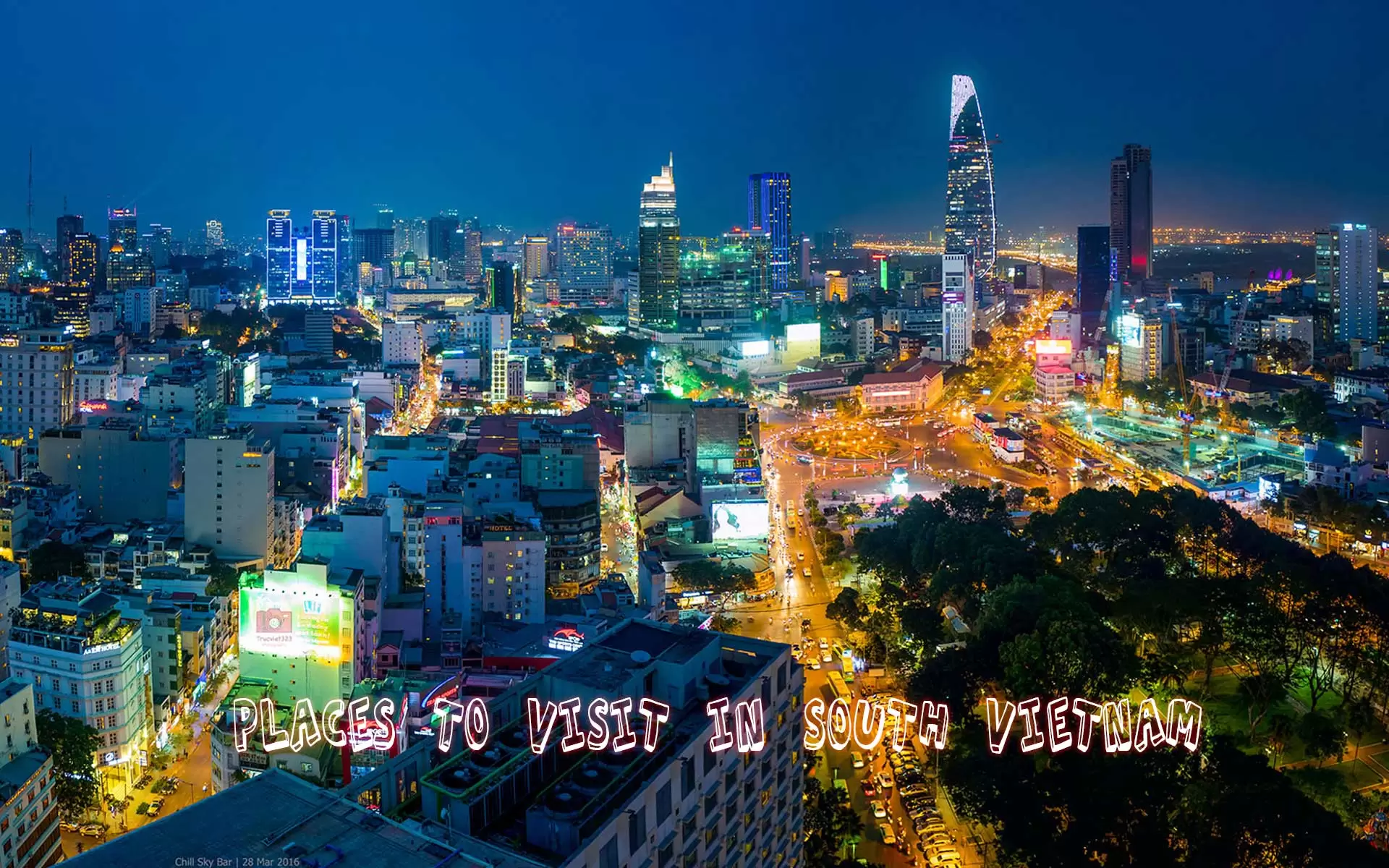
Places to visit in South Vietnam
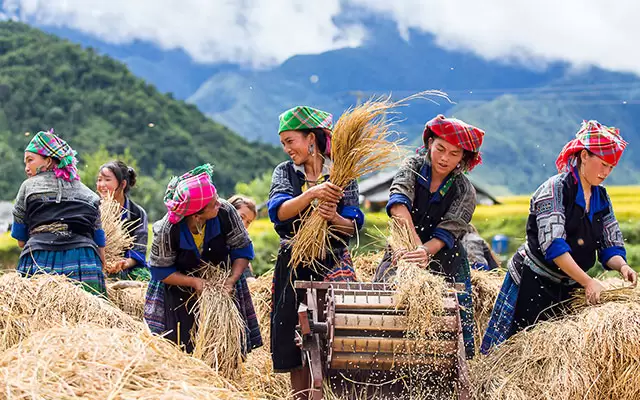
Top must-visit places in North Vietnam
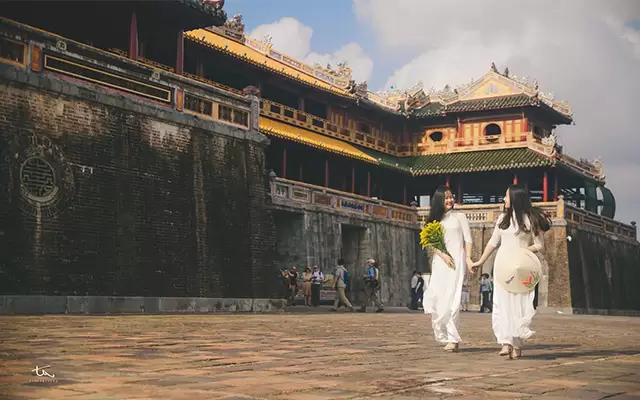
Highlight Destinations in Central Vietnam
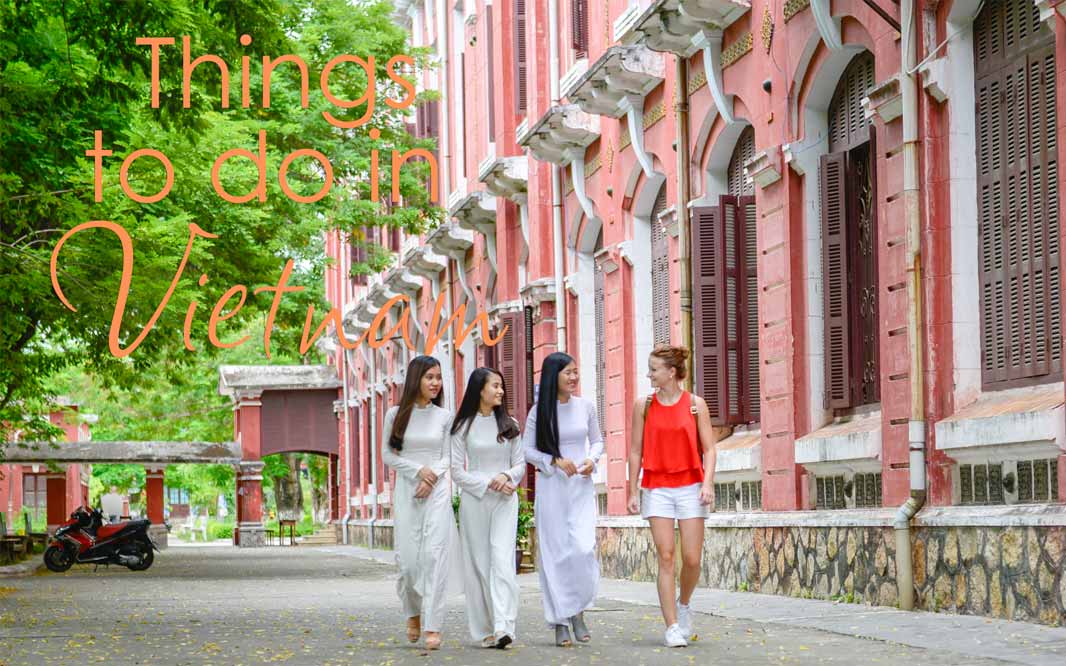
20 Best Things to Do in Vietnam in 2025

Best Vietnam Private Tours you should know before traveling
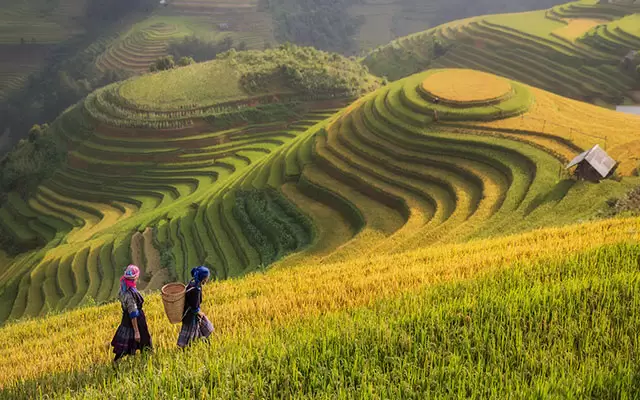
Things to know before traveling to Vietnam
Useful information
Leave a Comment Cancel comment
Request a free quote, thank you we have received your travel request. you will receive an email shortly. please check your email and verify the information. your request will be processed after your confirmation..
You have chosen a tour duration longer than 20 days. Please specify the exact number of days you want to travel in the message box below, so that we can have enough information and make a program for you. Thank you for your cooperation.
You have selected a number of travellers greater than 20. Please let us know the exact number of people in your group in the message box below so that we can quote you accurately. Thank you for your cooperation.
You have selected a number of travellers and duration greater than 20. Please let us know the exact number of people in your group and the exact number of days in the message box below so that we can quote you accurately. Thank you for your cooperation.
- Vietnam Travel Guides
- Travel Planning
- Festivals & Events
- Food & Drinks
- Tourist Maps
- Travel Blog
- Travel News
Our Recommendations
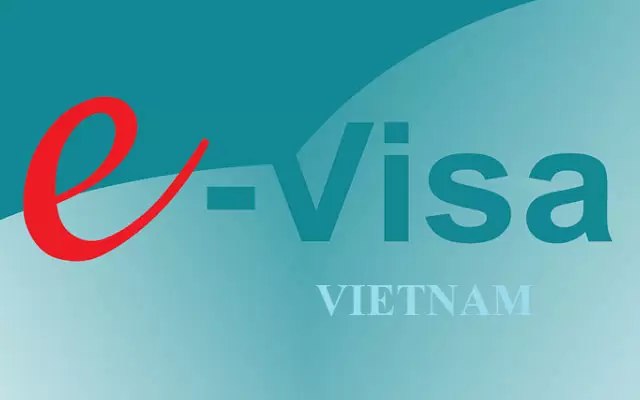
Guideline to get Vietnam E-visa
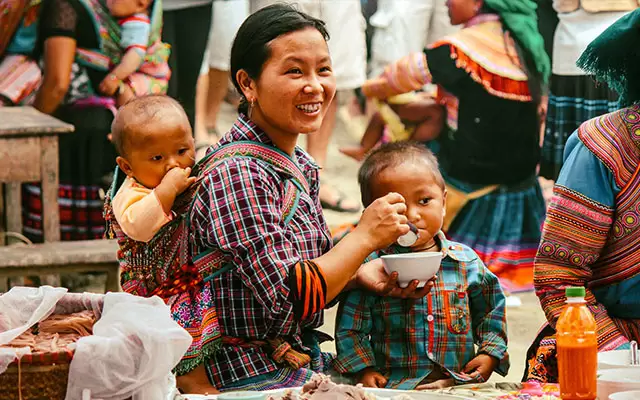
Vietnam Weather: General information & Best Time to Visit
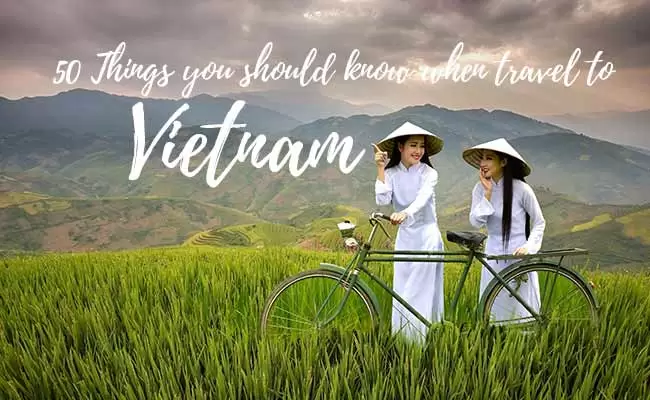
50 Things You should Know before Traveling to Vietnam

Info for travelers on Covid-19 in Vietnam: Entry requirements & Restrictions
You May Also Like
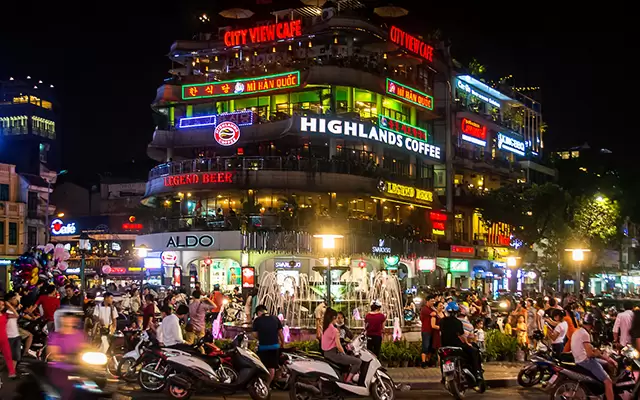
Hanoi Old Quarter, things to know
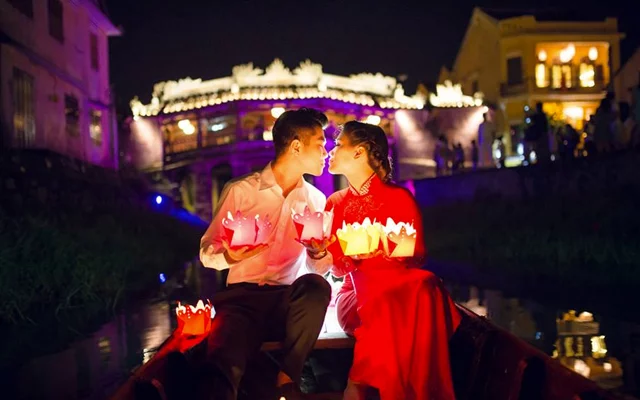
The 9 Best Nightlife in Hoi An
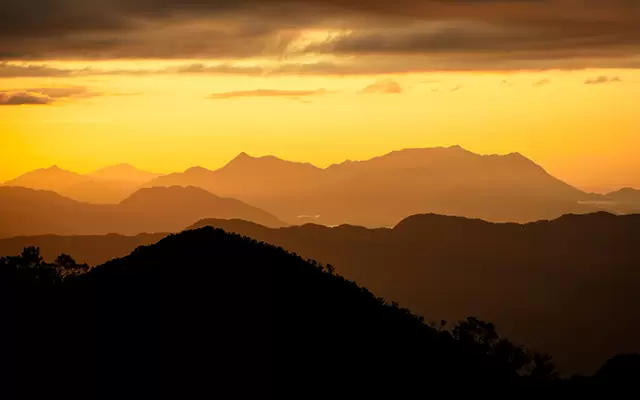
10 Famous Mountains In Vietnam
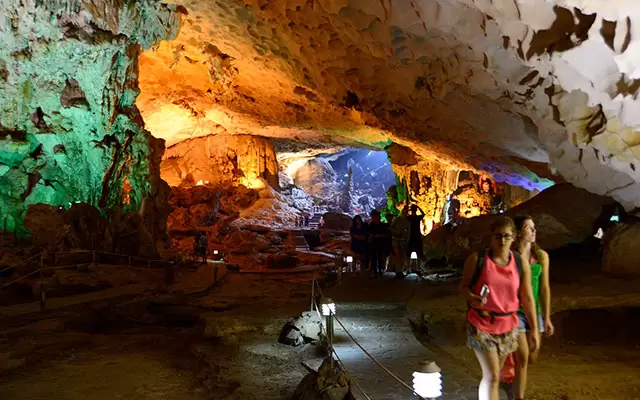
Thien Cung Cave – Halong Bay
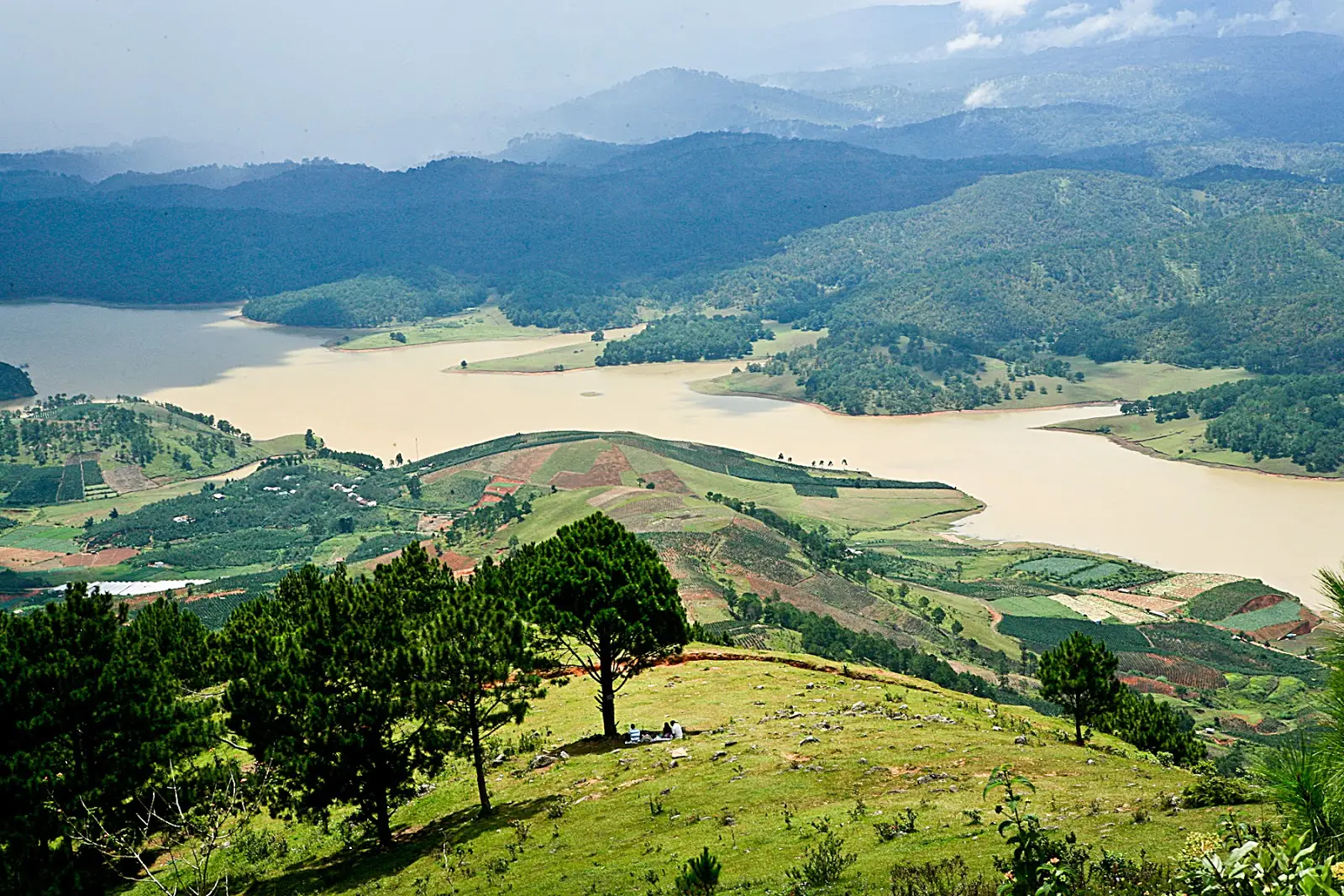
Dak Lak Tourism Guide 2025
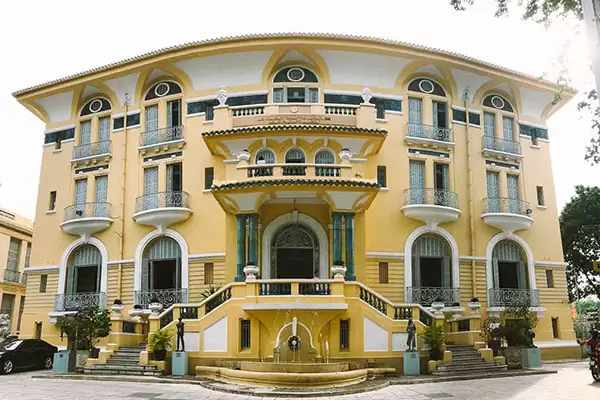
Fine Art Museum of Ho Chi Minh City
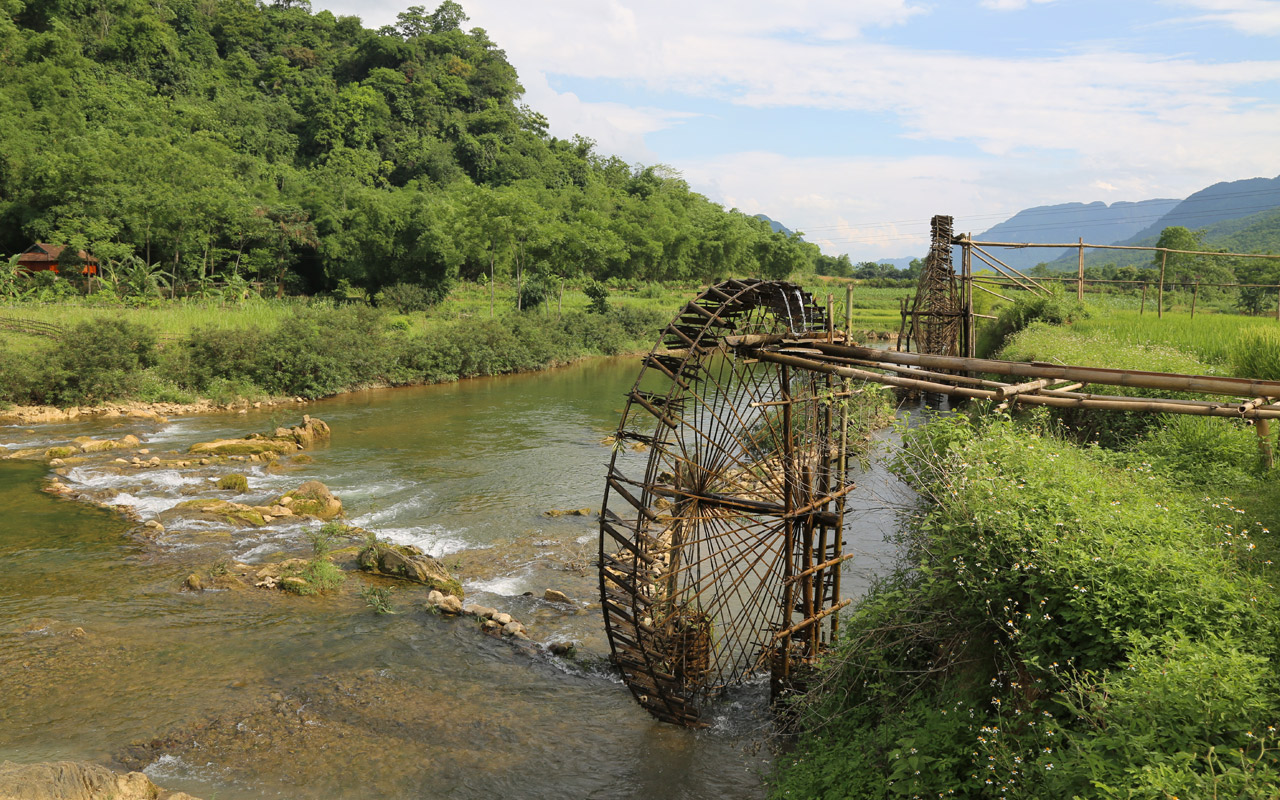
Best Destinations for Trekking and Hiking Adventures in Vietnam
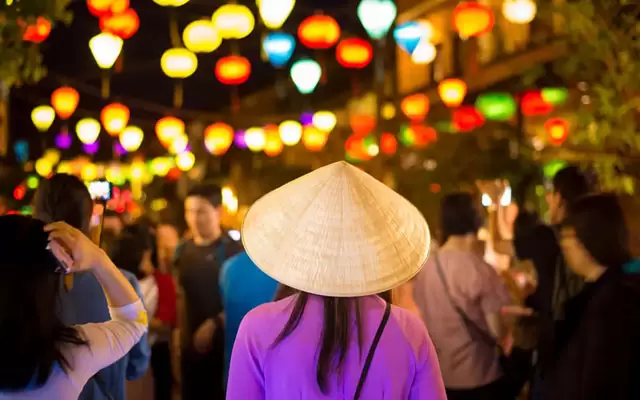
Hoi An Night Market – A Shopping Paradise
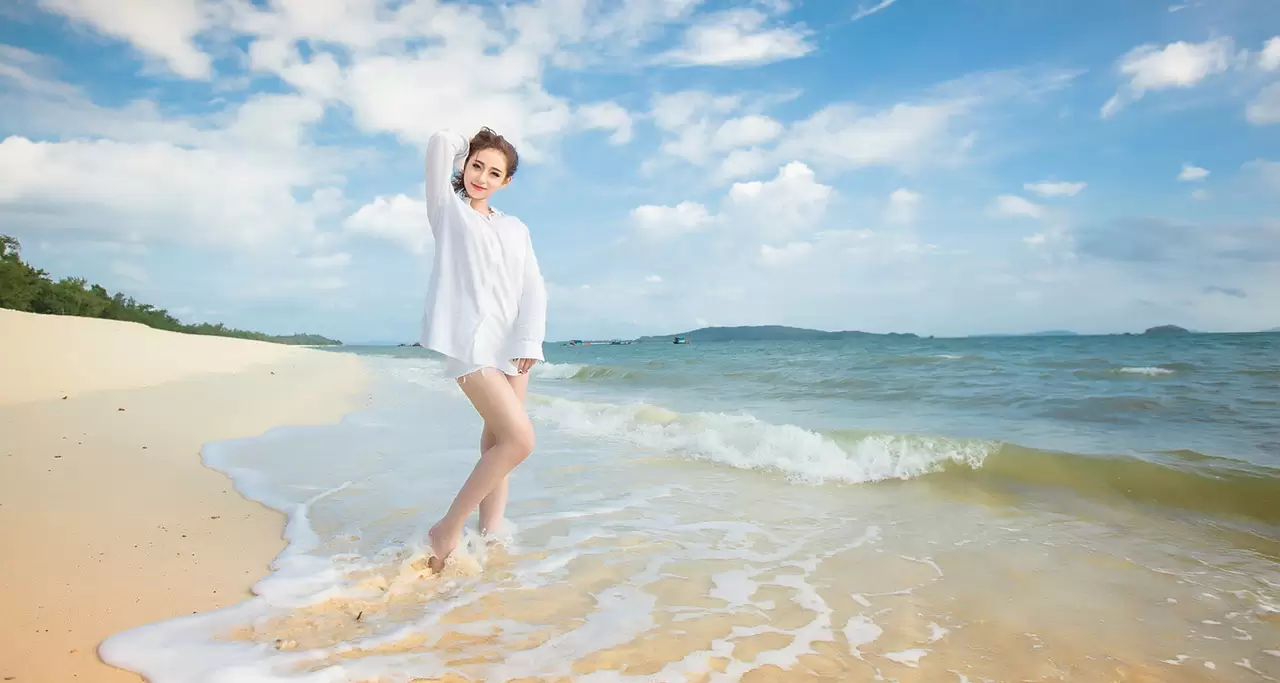
Vietnam Beaches – A Guide to the Best and Most Beautiful Coastlines
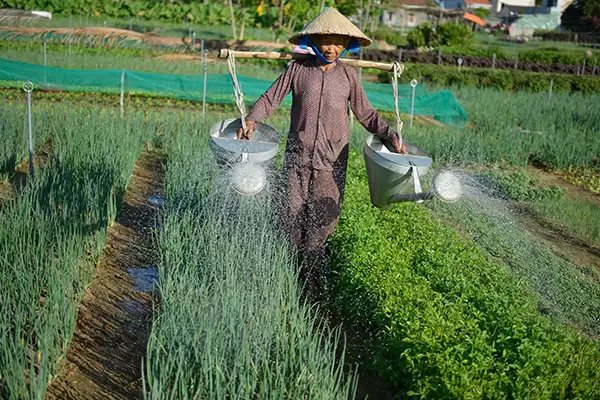
15 Vietnam villages you should visit
Sign up today and receive a customized itinerary based on your own travel style, budget… by our Vietnam Travel consultants
* To be sure you'll receive our itinerary (email failure case...)
(We'll get back to you within 8 business hours)

IMAGES
VIDEO
COMMENTS
Ho Chi Minh City. Ho Chi Minh City Hall. For big city fans, no visit to Vietnam is really complete without a visit to Ho Chi Minh City, the buzzing commercial hub of the country. The streets are an insane clog of motorbikes and cars, the restaurant and café scene is incredibly cosmopolitan, and the shopping is the best in the country.
10. Ha Giang. Best for mountain views. Trekking to the minority villages in the hills around Sapa is one of Vietnam's top draws, but the country's trekking capital feels rather commercialized these days. Hikers have to walk further every year to find the rural idyll that first drew people to the northwest.
18. Temple of Literature in Hanoi. 25. Khai Dinh Tomb in Hue. Blending both Vietnamese and European design elements, the architecture of the Khai Dinh Tomb in Hue has been described as Buddhist as well as Roman Gothic. Constructed in the 1920s, the tomb was commissioned by the Emperor of Vietnam as his own future tomb.
2024. 5. Hoi An Ancient Town. 27,406. Points of Interest & Landmarks. Historic neighborhood adorned with colorful lanterns, offering a blend of vibrant markets, traditional architecture, and local culture, ideal for nighttime exploration and cultural immersion. See ways to experience (728) 6. Sun World Ba Na Hills.
Hang Son Doong. Hang Son Doong (Mountain River Cave) is known as the world's largest cave, and is one of the most spectacular sights in Southeast Asia, with access only approved by the government in 2013. This enormous cave was discovered quite recently. Ho Khanh, a hunter from a jungle settlement close to the Vietnam-Laos border, would often ...
12. Enter the world's largest cave in Phong Nha. Phong Nha-Ke Bang National Park in north central Vietnam is a lost world of jungles and caverns, including the world's largest, Hang Son Doong. The scale of this wonder of nature is simply mind-blowing - a 747 airplane could fly through the cave's main tunnel.
Admission tickets from ₹1,597. Three-story museum presents a raw, educational perspective on the Vietnam War through graphic photographs, military artifacts, and themed exhibits. Not recommended for young children. See ways to experience (259) 2024. 4. Halong Bay. 11,579. Bodies of Water.
17. Da Nang. Nestled on the central coast of Vietnam, Da Nang is an energetic coastal city with a historic French colonial port. It is known primarily for its fantastic beaches, including the famous My Khe Beach, which Tripadvisor has named as one of the best beaches in Asia.
Halong Bay. 11,551. Bodies of Water. Limestone karst landscape with emerald waters, ideal for kayaking, cave explorations, and tranquil overnight cruises. UNESCO site with rich biodiversity and cultural heritage. See ways to experience (837) 2024. 5. Hoi An Ancient Town.
Before planning a trip to Vietnam, you must do a lot of research to find out the top tourist attractions to visit.Among the top tourist attractions in Vietnam, iconic sites like Ha Long Bay, the Imperial City of Hue, and the historic Old Quarter of Hanoi are must-sees. Thanks to such a huge stretch from the North to the South, over 3200 kilometers, crossing various topographies, Vietnam holds ...